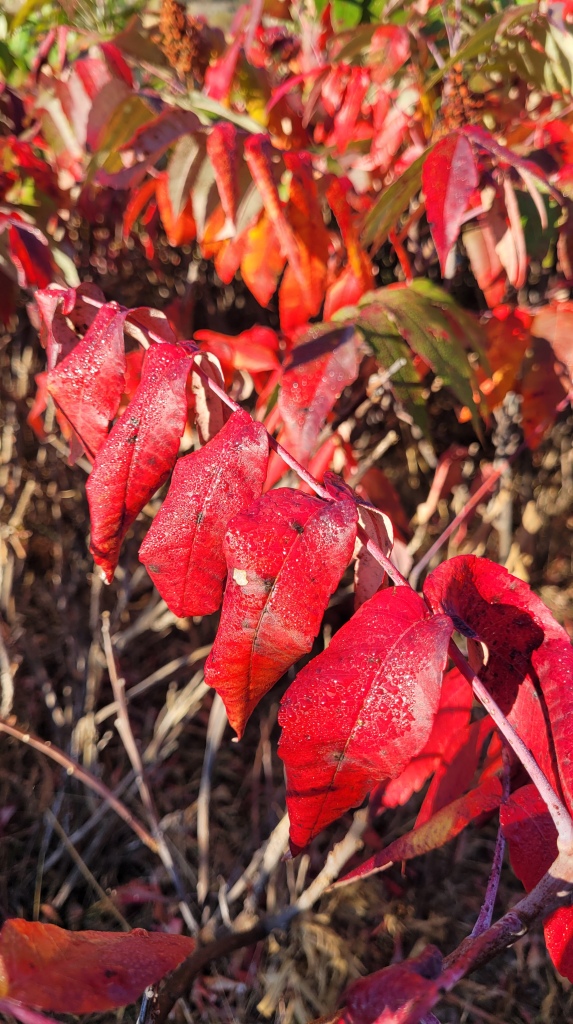VLBO 2023 Banding Season Jobs
Please click the following links to see the full postings for our Bander-in-Charge and Assistant Bander Positions.
2022, Week 10: Oct. 10 – Oct. 15
The final week of our 2022 fall migration monitoring season turned out to be decently productive given this is usually the slowest week of the season. We banded 57 birds of 18 species which is technically more than last week since Week 11 has only 6 days, but still below the long-term average of 66. The daily banding mean is 9.5 birds compared to 7.9 last week, including a surprising total of 22 birds on Wednesday. The final two days were more typically slow for the final week with 6 and 5 banded, respectively. The species total of 18 actually ties the record high for Week 11, set back in 2011, with the average being 14. We also recaptured 22 birds of 6 species. Beautiful, warm and clear days punctuated what was a pleasantly warm and sunny fall. In fact, we did not get any frost this season, which normally occurs at least once or twice late in the season during October.
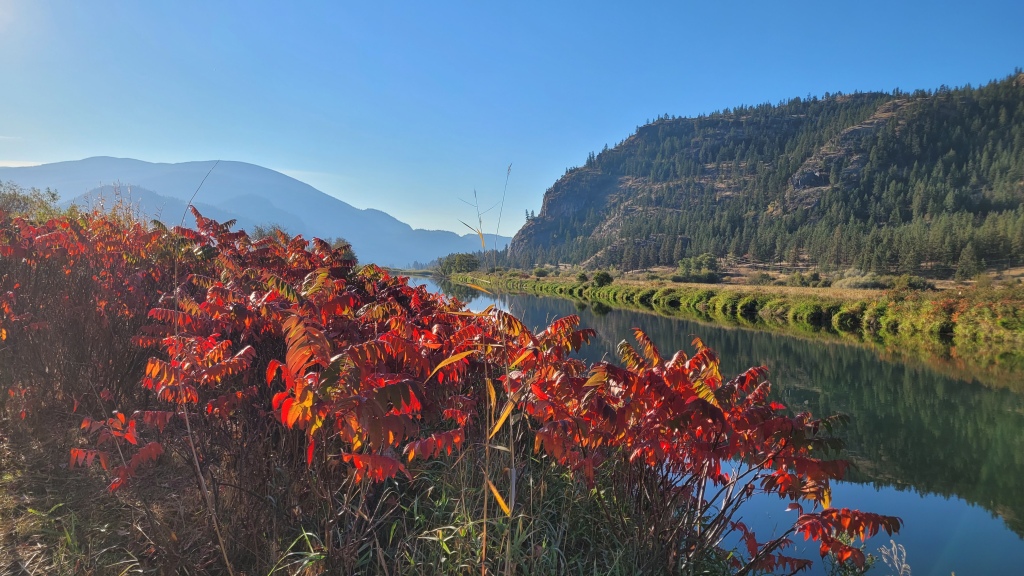
Despite being slow, the final days were quite exciting as indicated by the high species total, with three new species banded. These included the best bird of the season on the final day – an American Tree Sparrow, only the 2nd ever banded here! A Brown Creeper (only the 11th record) and a Golden-crowned Kinglet were also new this season. Other exciting moments included the capture of our second Pacific Wren, a flock of 13 American Goldfinches in net 9 early on Wednesday morning, and a record-breaking 10th Swamp Sparrow!
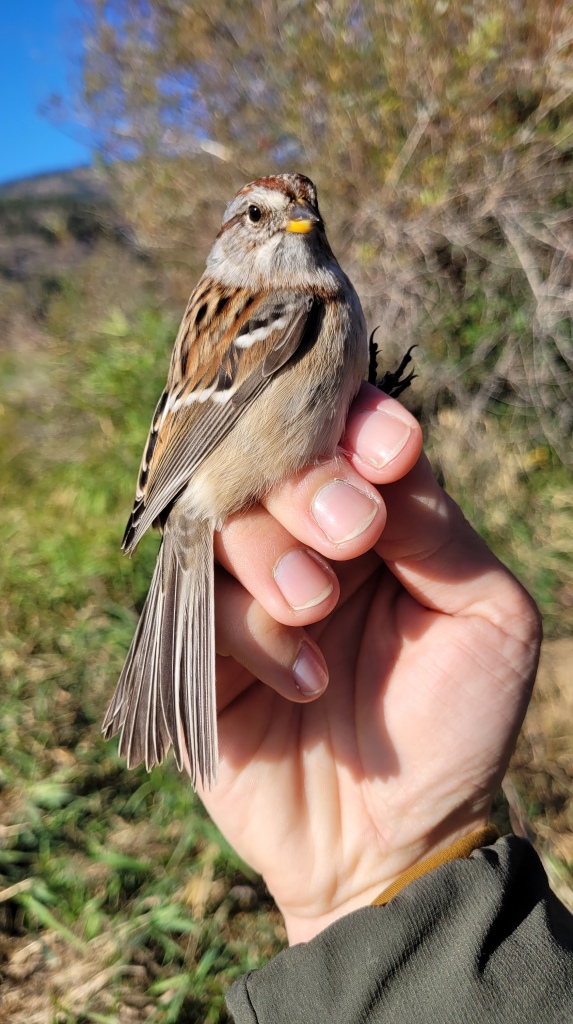
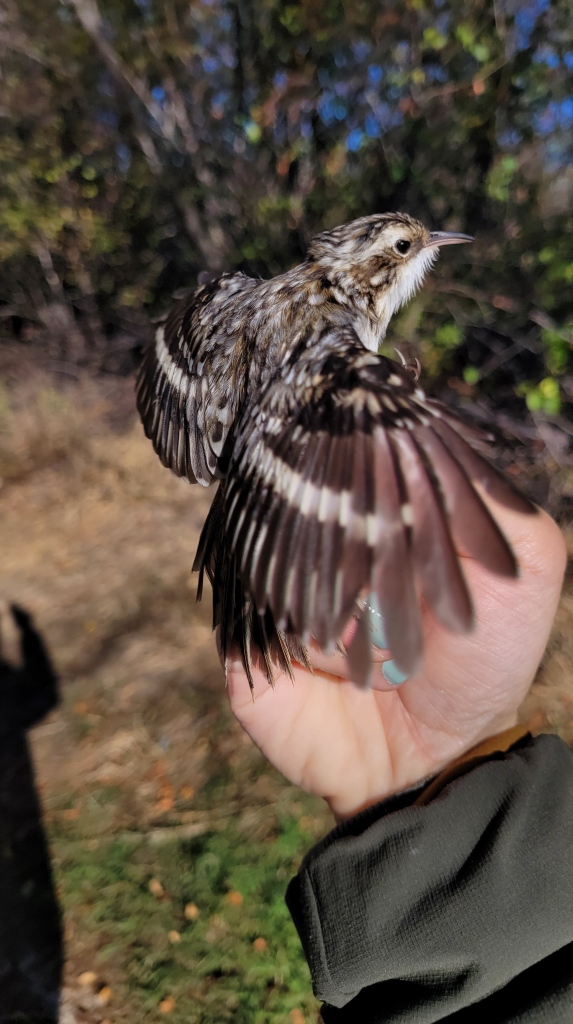
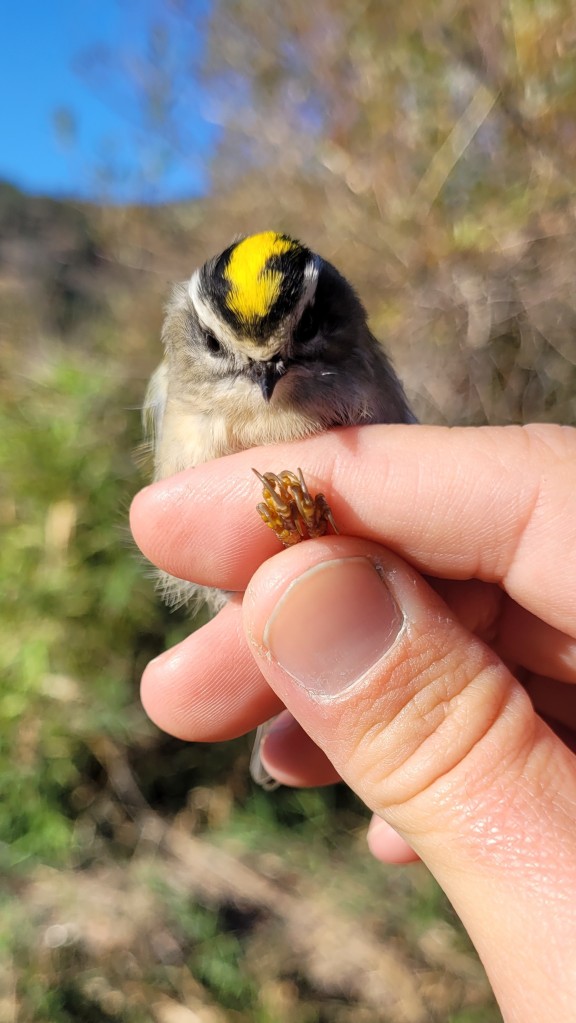
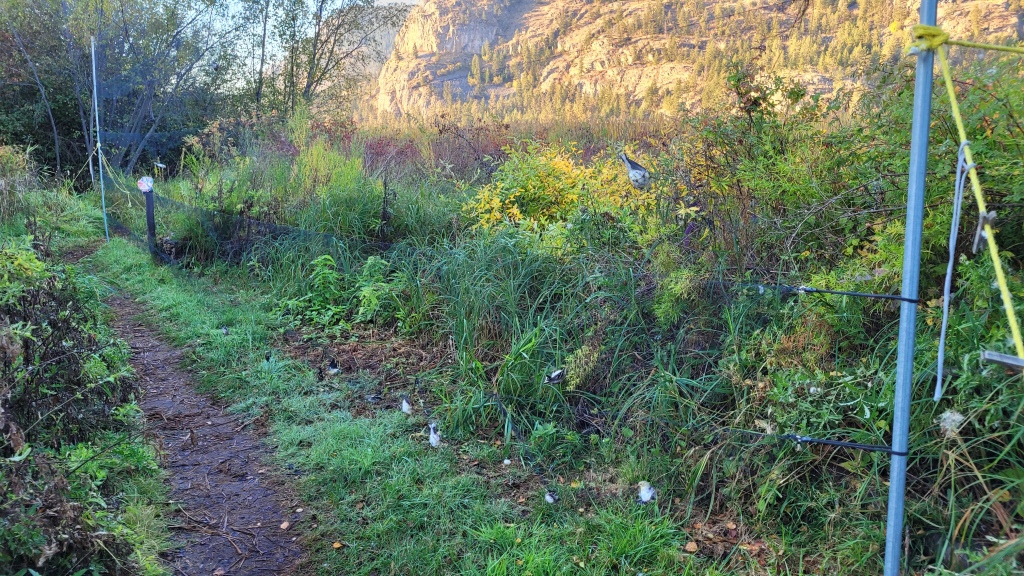
Not surprisingly, American Goldfinch topped the banding list this week with all 13 captures coming at once, followed by Ruby-crowned Kinglet with 9, then Oregon Junco with 8 and ‘Audubon’s’ Yellow-rumped Warbler with 5. Kinglets and Yellow-rumped Warbler were slightly above average this week while Song and Lincoln’s Sparrows were well below average, and Oregon Juncos and Marsh Wren were just on par.


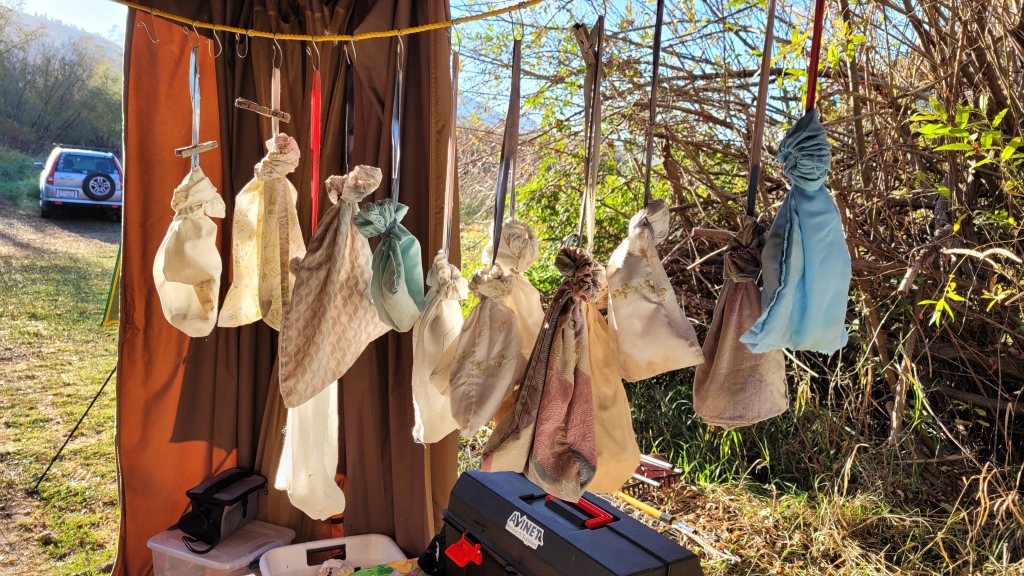
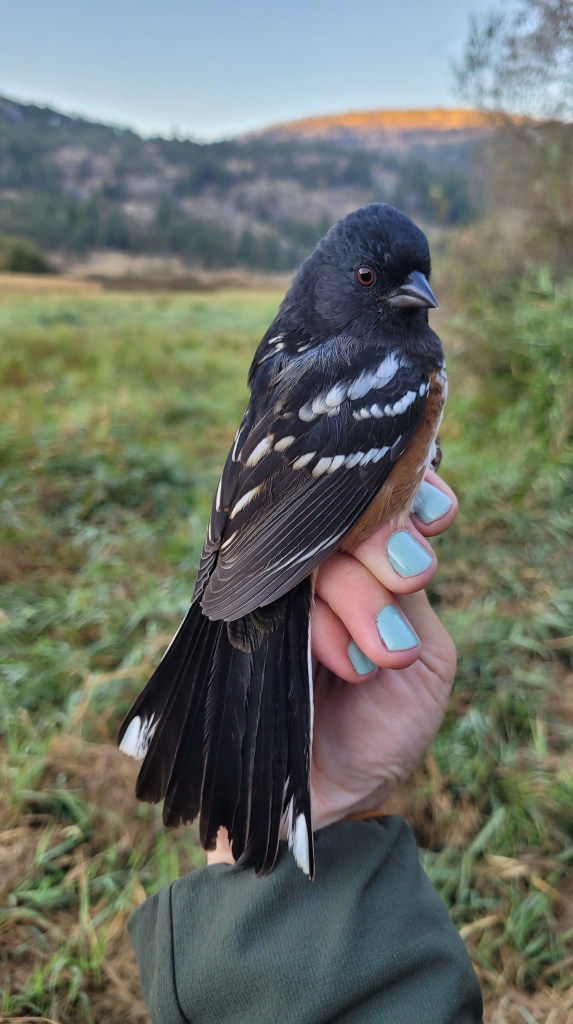
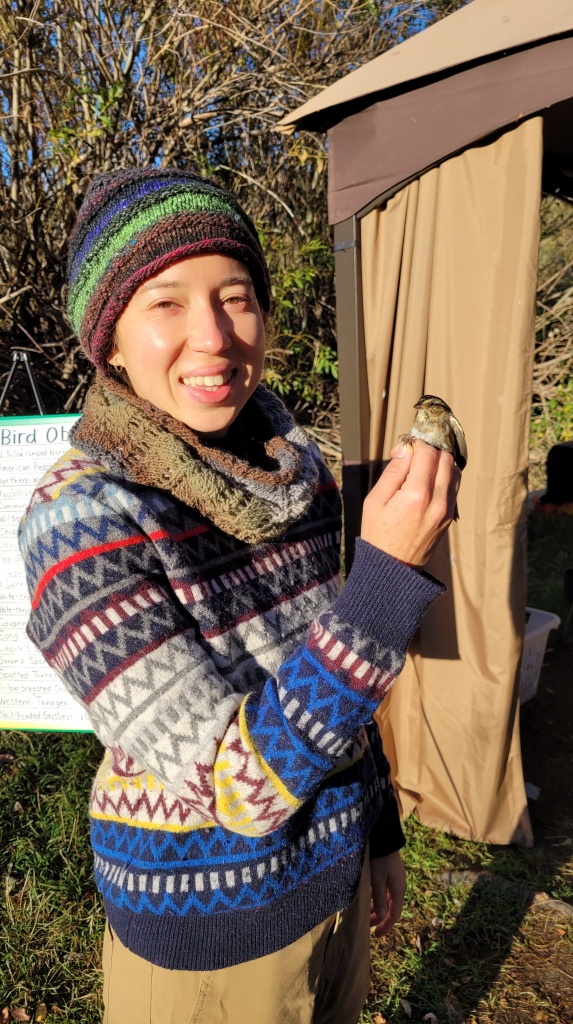
The month of October concluded with only 140 birds banded, making it the slowest October on record at VLBO. It is a far cry from last year’s late season surge total of 355, and well below the long-term average of 220. We banded 20 species during the month which is also below the long-term average of 23.
The final 2022 season totals stand at 1451 birds banded of 58 species and 347 recaptures of 25 species. These totals are considerably lower than recent seasons and are more comparable to totals in the early 2010s. Based on banding totals, this is the least productive season since 2013 and is only 76% of the long-term standard banding total mean of 1902 birds banded (since 2006 when banding in October started). Causes for such low numbers this season are likely complex and difficult to ascertain. However, we speculate that the late, wet spring and probable consequent reduction in the number of young produced may be a factor. Another could be the clear skies and mostly calm conditions throughout the fall which failed to produce good conditions for migrant fallout in our region. Some of our busiest banding days in the past have occurred under inclement weather conditions or afterwards.
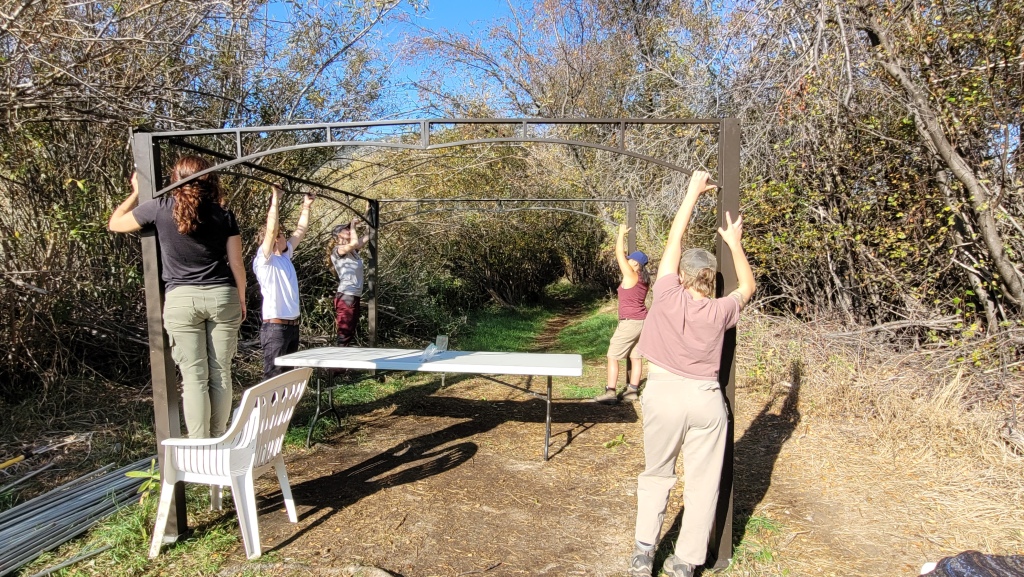
Volunteers help deconstruct the banding tent.Thanks to all the volunteers who lent almost 500 hours of their time this season! We could not have done it without them.
Below are the weekly and season banding totals:
| Species | Total Banded |
| American Goldfinch | 13 |
| Ruby-crowned Kinglet | 9 |
| ‘Oregon’ Dark-eyed Junco | 8 |
| ‘Audubon’s’ Yellow-rumped Warbler | 5 |
| Song Sparrow | 4 |
| Marsh Wren | 3 |
| ‘Unidentified’ Yellow-rumped Warbler | 2 |
| Black-capped Chickadee | 2 |
| Lincoln’s Sparrow | 2 |
| American Tree Sparrow | 1 |
| Spotted Towhee | 1 |
| Bewick’s Wren | 1 |
| Brown Creeper | 1 |
| Swamp Sparrow | 1 |
| Pacific Wren | 1 |
| Virginia Rail | 1 |
| Golden-crowned Kinglet | 1 |
| White-crowned Sparrow | 1 |
| Total | 57 |
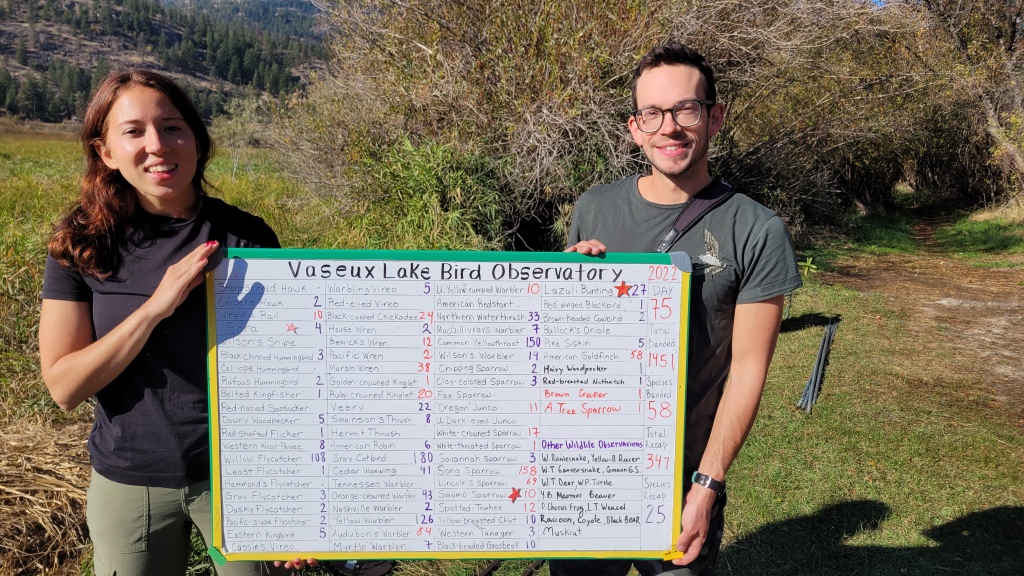
2022, Week 10: Oct. 3 – Oct. 9
The penultimate week of our banding season continued the slow, downward trend of the previous week with only 55 birds banded. This is the fewest birds ever banded during Week 10 in the station’s history with the total being exactly half the long-term average (since 2006) of 110 birds banded for week 10. Last year we experienced the most productive Week 10 on record with 207 birds banded, making the current week seem especially quiet. It was a more diverse week than last with 15 species banded, though still slightly below the long-term mean of 16.5. We also recaptured 20 birds of 8 species; and perhaps the most interesting of these were two Swamp Sparrows. The busiest day of the week was Tuesday with 13 birds banded, whereas Thursday brought our slowest day of the season with only 3 new birds. Weather conditions continued in very similar fashion to last week, with cool mornings (but still no frost), warming up to low 20s by early afternoon with mostly clear skies and little wind.
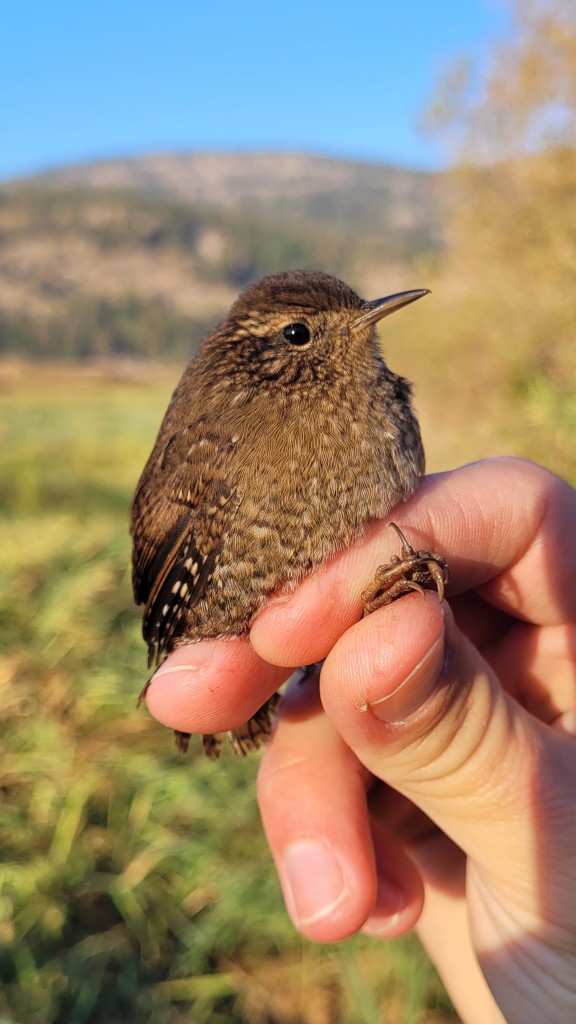

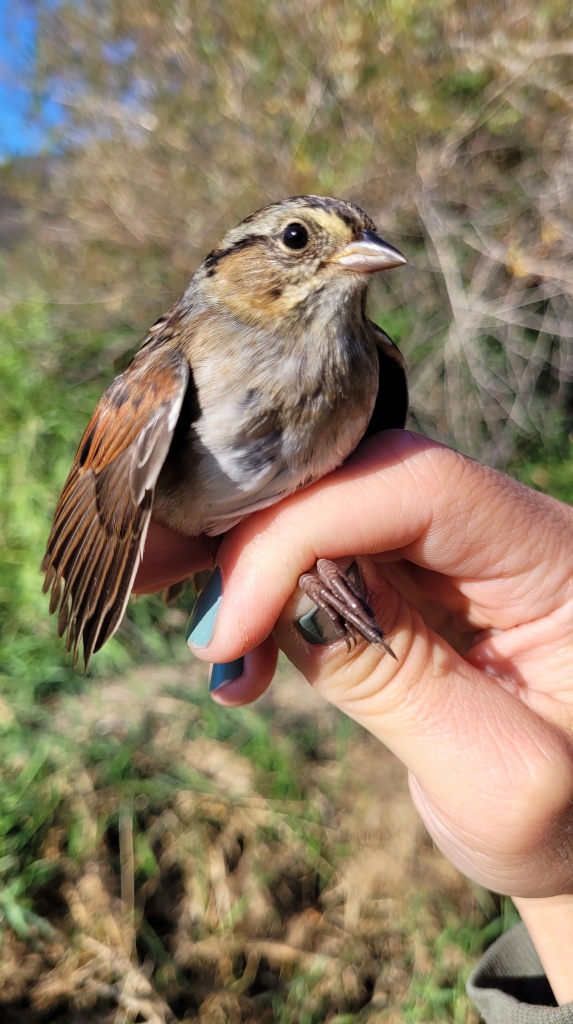
Only one species was new for the season this week – a single Pacific Wren in net 8 early Sunday morning. We usually catch one Pacific Wren each October and this individual was right on time. A few other novel captures kept things interesting, including a very late Nashville Warbler, only our second of the season, and three more Swamp Sparrows, which brings our season total to 9 – a tie for the record set in 2012!
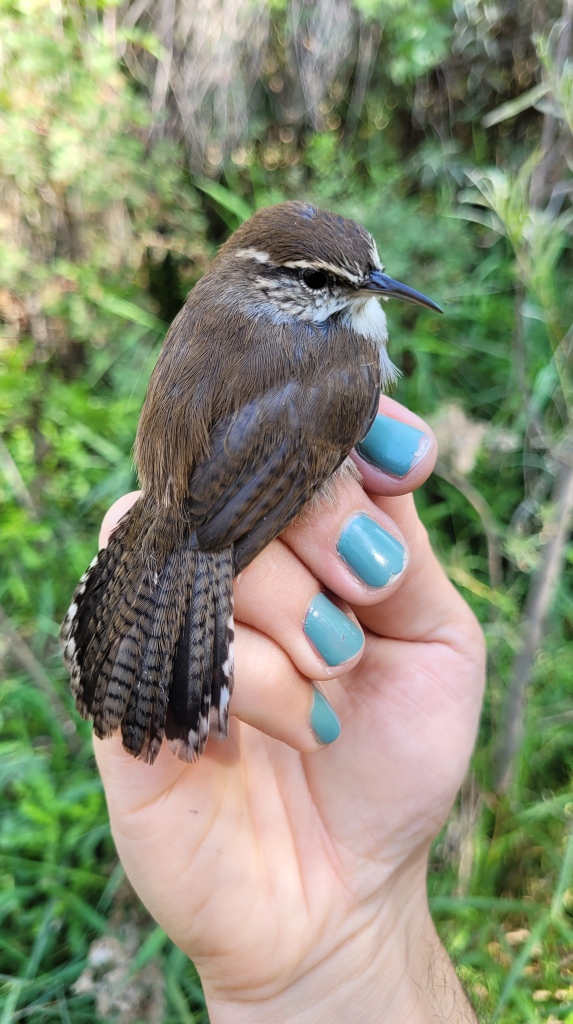
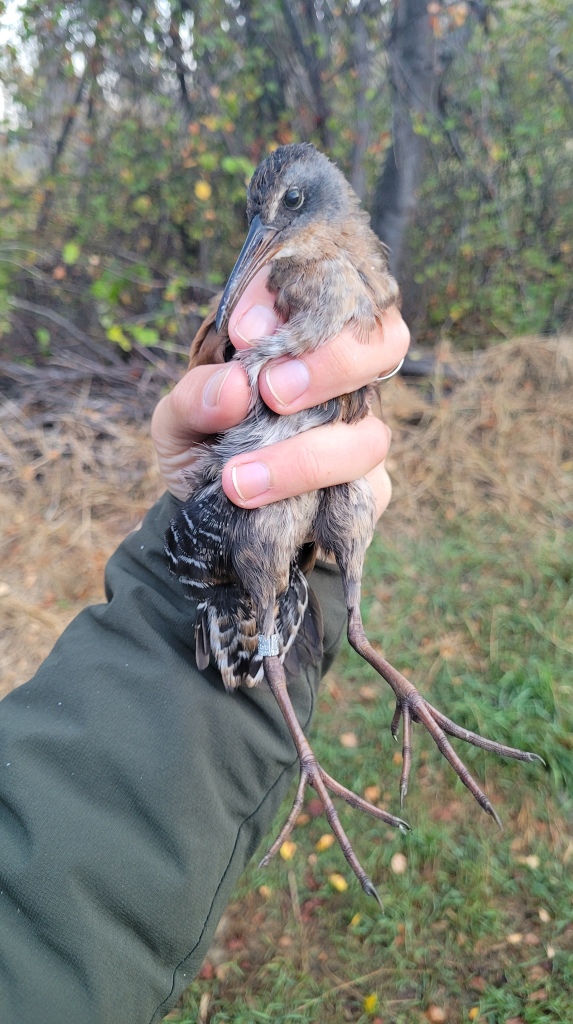
Song Sparrow was the most banded species for the second week in a row with 12 banded, followed by Marsh Wren with 7, Ruby-crowned Kinglet with 6, and then ‘Audubon’s’ Yellow-rumped Warbler with 5. Despite being in the top four, these species were still below average for week 10, with the exception of Marsh Wren, which really demonstrates how low our numbers have been. American Goldfinch and Swamp Sparrow were the only other species with above-average numbers this week. On the other hand, Ruby-crowned Kinglet, Lincoln’s Sparrow, Dark-eyed Junco, and all warbler species were banded in less than half of their respective average number for Week 10.
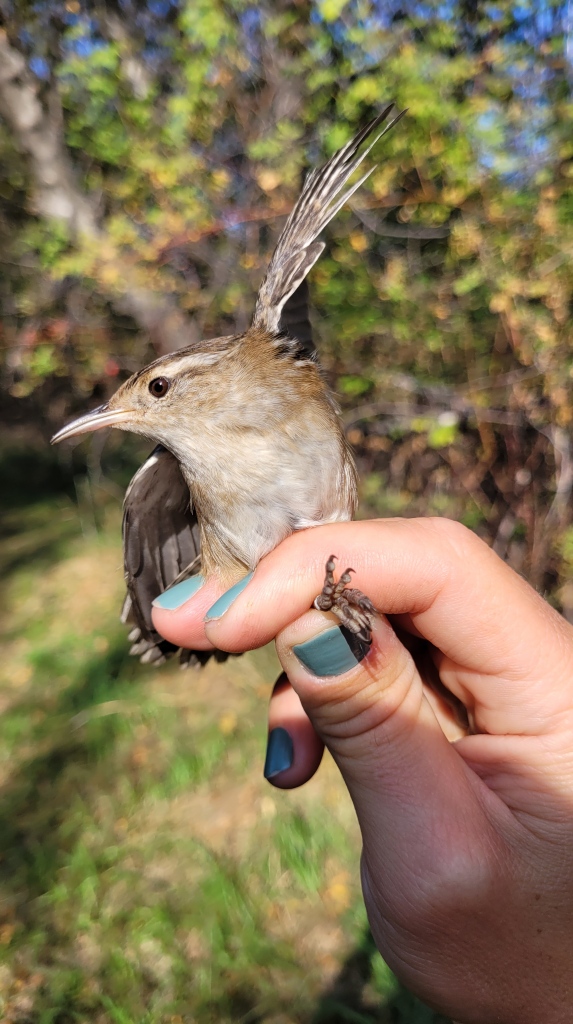


Our season total is now just shy of 1400, which is about 73% of our long-term station average after week 10. With only one week remaining (typically our slowest week), it’s hard to imagine that we’ll see much of an increase in activity at the end. Stay tuned…
Below are the weekly banding totals:
| Species | Total Banded |
| Song Sparrow | 12 |
| Marsh Wren | 7 |
| Ruby-crowned Kinglet | 6 |
| ‘Audubon’s’ Yellow-rumped Wabler | 5 |
| American Goldfinch | 4 |
| Lincoln’s Sparrow | 3 |
| Swamp Sparrow | 3 |
| Orange-crowned Warbler | 3 |
| ‘Oregon’ Dark-eyed Junco | 2 |
| Black-capped Chickadee | 2 |
| White-crowned Sparrow | 2 |
| Virginia Rail | 1 |
| Nashville Warbler | 1 |
| ‘Unidentified’ Yellow-rumped Warbler | 1 |
| Pacific Wren | 1 |
| ‘Myrtle’ Yellow-rumped Warbler | 1 |
| Spotted Towhee | 1 |
| Total | 55 |
2022, Week 9: Sep 26 – Oct. 2
Week 9 of our fall migration monitoring season brought a very tame end to one of the slowest Septembers we’ve seen in a while at VLBO. We banded only 65 new birds of 14 species and recaptured 23 birds of 7 species, making this the slowest week of the season and one of the quietest in recent memory. The long-term station average for this week is 149 birds of 17 species, and the mean across the last five years is 254 birds, to put things into context. The first half of the week saw daily banding totals in the single digits, before rising into the teens for the latter half. The weather once again remained stagnantly calm, clear and warm with the only exception being Thursday when we had a light cloud layer.
Of the 14 species banded this week, two were new for the season: Red-breasted Nuthatch and Swamp Sparrow, of which we ended up banding six! As an uncommon fall migrant, we rarely band more than a couple in a season so getting this many in one week is quite interesting. In fact, it’s already the second highest season total we’ve ever had for Swamp Sparrow!
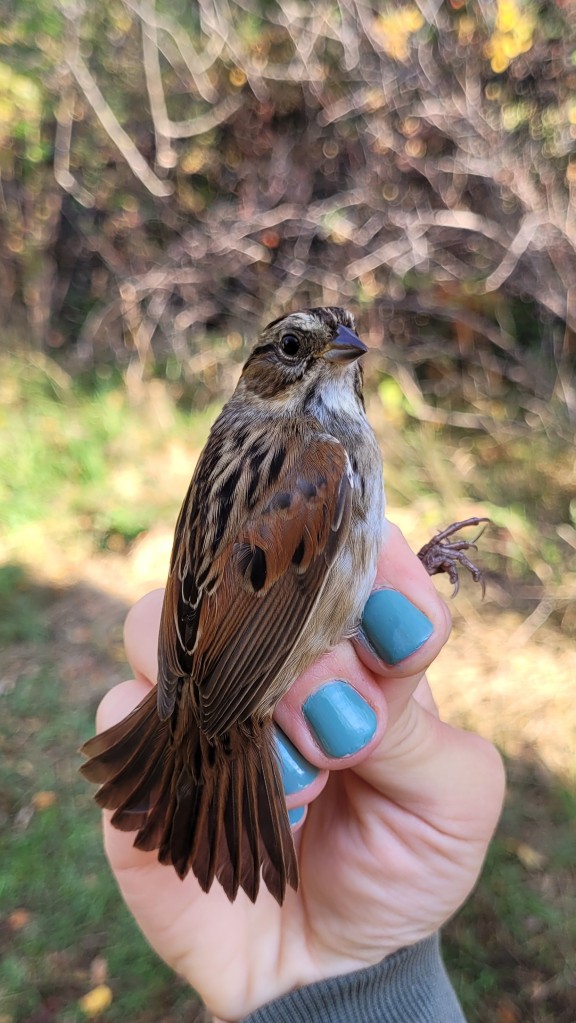
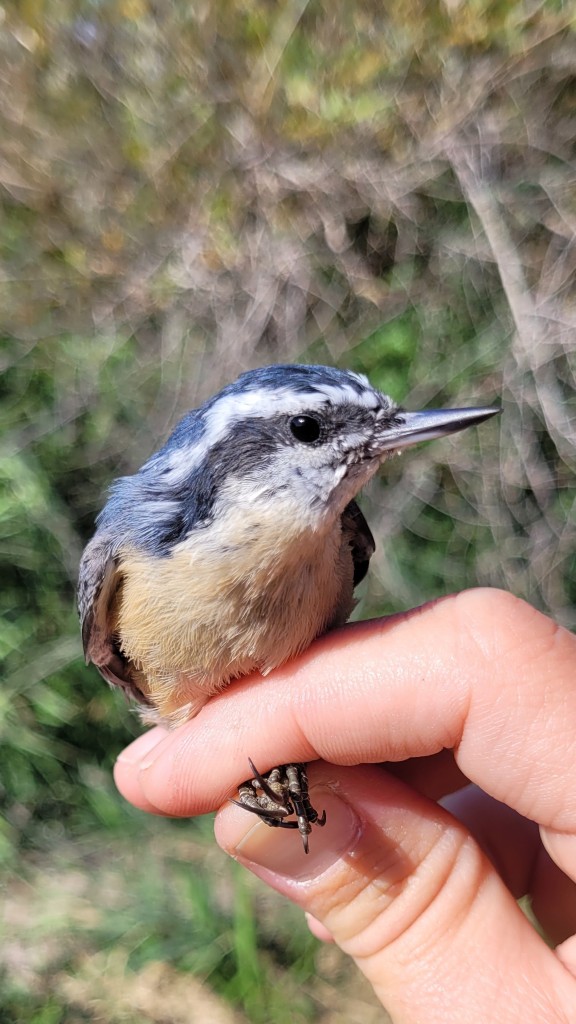
Song Sparrow topped the list of most banded birds this week with 11, while Audubon’s Warbler was a close second with 10, followed by Marsh Wren, Lincoln’s Sparrow, and Swamp Sparrow with 6 each. Not surprisingly, considering the low total for the week, these species are all well below average for week 9, with the exception of Marsh Wren and Swamp Sparrow. Most species were half the long-term average banded for week 9 or less, with our normally common migrants, Orange-crowned Warbler, Common Yellowthroat, and Ruby-crowned Kinglet, at only at 25% of average or less. Interestingly there has been a resurgence of American Goldfinch presence at the station which we don’t band frequently this late in the season. We also surprisingly netted three Cedar Waxwings late on Friday.
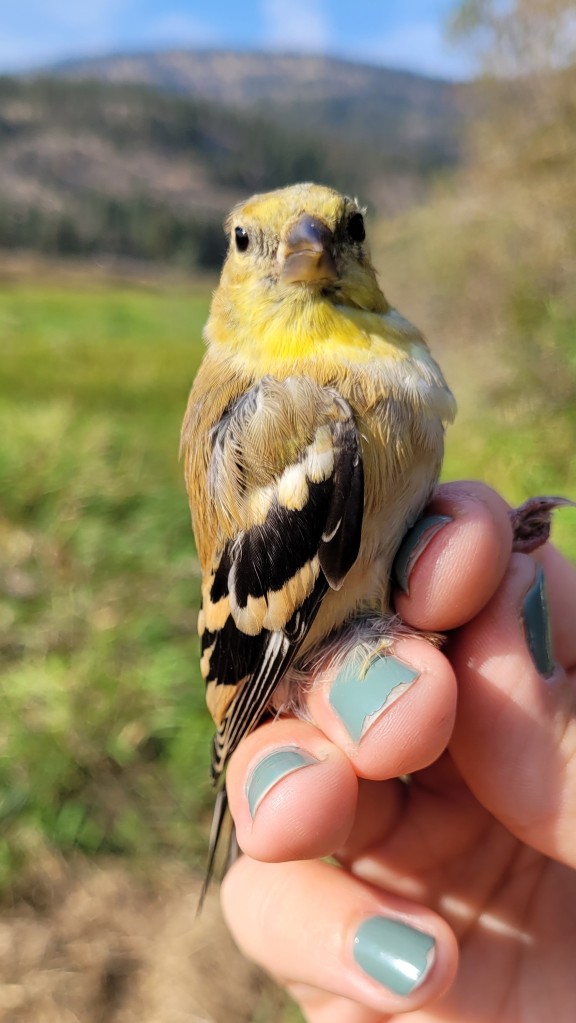

September concluded with only 536 birds of 40 species banded, which is the lowest total since 2013. It pales in comparison to most recent seasons and is 250 birds below the long-term mean for September. However, the species total is one more than the long-term mean. It’s difficult to ascertain correlative reasons for this low total, but the clear skies and calm winds likely have a role to play. We witnessed only one day of decent fallout this month, which is when birds are forced out of the skies by rainy and overcast weather to wait for better conditions for migration. September in the South Okanagan normally brings at least a few occurrences of rainy weather which cause good fallout and lead to busy banding days for us.
Below are the weekly banding totals:
| Species | Total Banded |
| Song Sparrow | 11 |
| ‘Audubon’s’ Yellow-rumped Warbler | 10 |
| Marsh Wren | 6 |
| Swamp Sparrow | 6 |
| Lincoln’s Sparrow | 6 |
| Orange-crowned Warbler | 5 |
| American Goldfinch | 4 |
| Cedar Waxwing | 3 |
| Common Yellowthroat | 3 |
| ‘Unidentified’ Yellow-rumped Warbler | 3 |
| Spotted Towhee | 2 |
| Ruby-crowned Kinglet | 2 |
| White-crowned Sparrow | 2 |
| Virginia Rail | 1 |
| Red-breasted Nutchatch | 1 |
| Total | 65 |

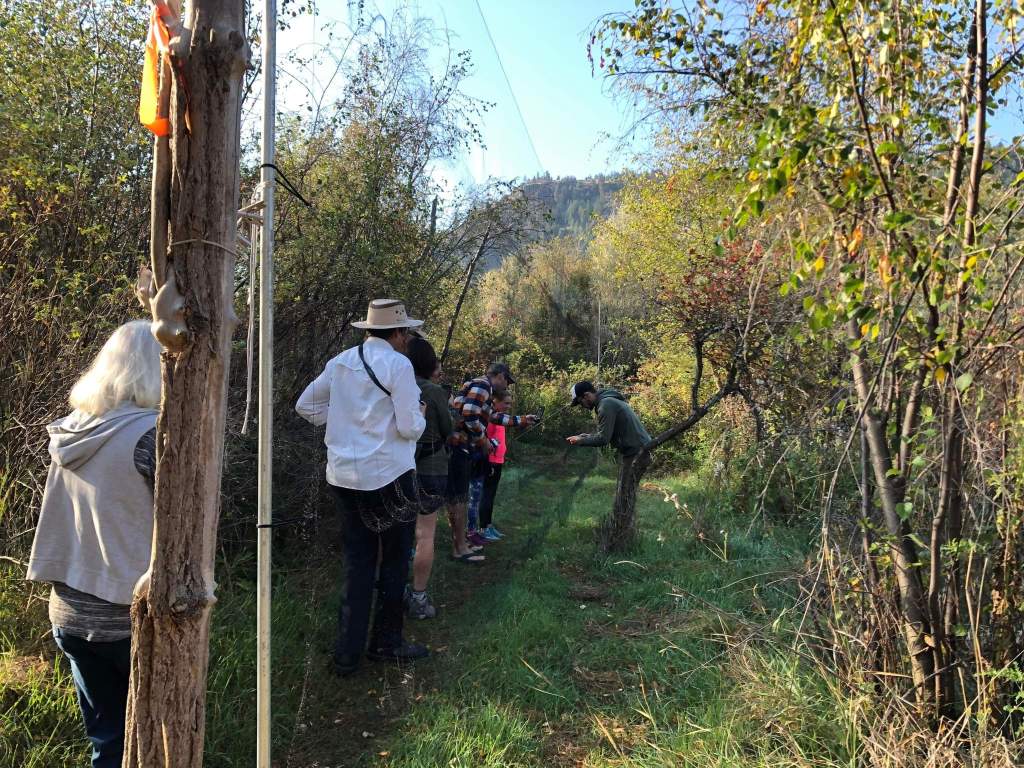
2022, Week 8: Sep 19 – 25
Week 8 of our banding season has passed and we did not see the upswing in migration activity that we hoped for. It was another slow week, with 152 birds banded of 18 species and 32 recaptures of 10 species. These numbers are well below average for what is typically our second busiest week during migrant season (after last week); on average we band 206 birds of 20 species during week 8, and last year we banded 384 of 2 species! This year’s low numbers may quite possibly be attributed to the continuing clear, sunny, warm days we’ve enjoyed in the South Okanagan. While morning lows have dropped to the single digits, the sun’s warmth consistently pushed temperatures up into the low-to-mid 20s by the end of our banding shifts, with few clouds in the sky. Birds tend to fly during clear weather, and the lack of rain and cloud cover may mean fewer reasons for them to stopover at VLBO.

Despite the low numbers, four new species kept things interesting: our first ‘Oregon’ Dark-eyed Junco, White-throated Sparrow, two rather late Ducky Flycatchers, and a Red-shafted Flicker. Other exciting captures included a MacGillivray’s Warbler, a species we hadn’t banded since week 6, two more Clay-colored Sparrows, and a very late Northern Waterthrush which we recaptured a day later!
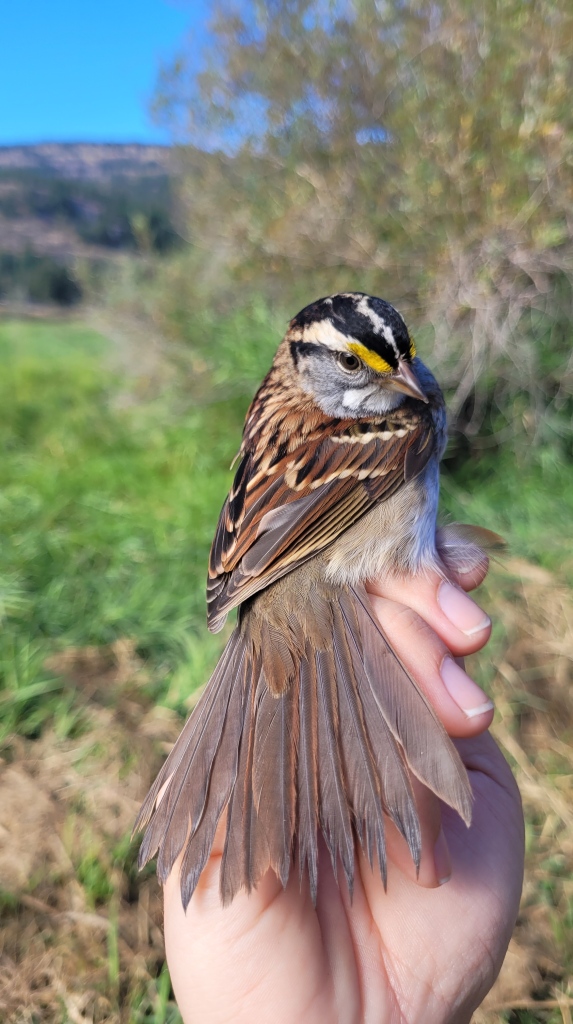
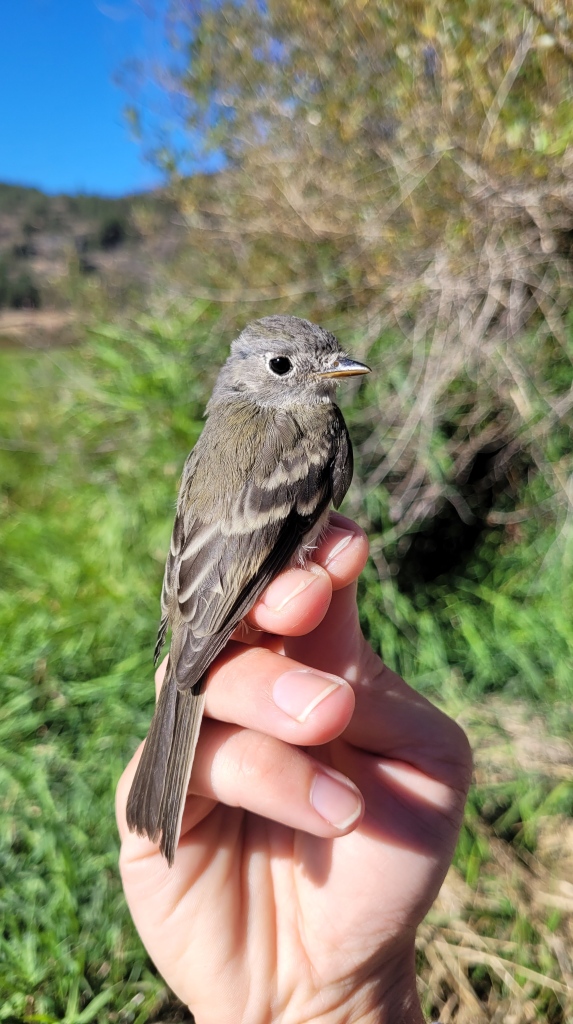
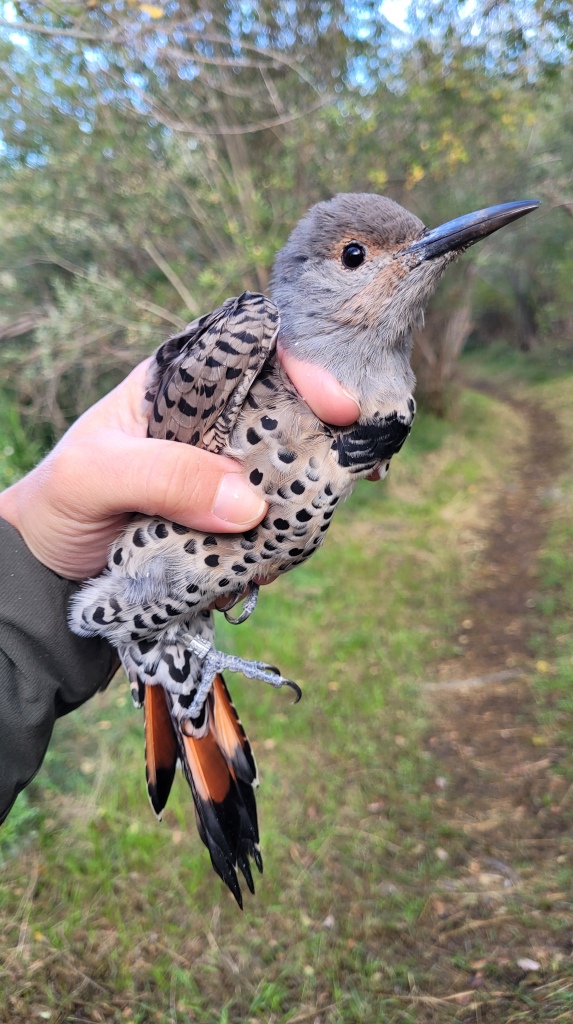
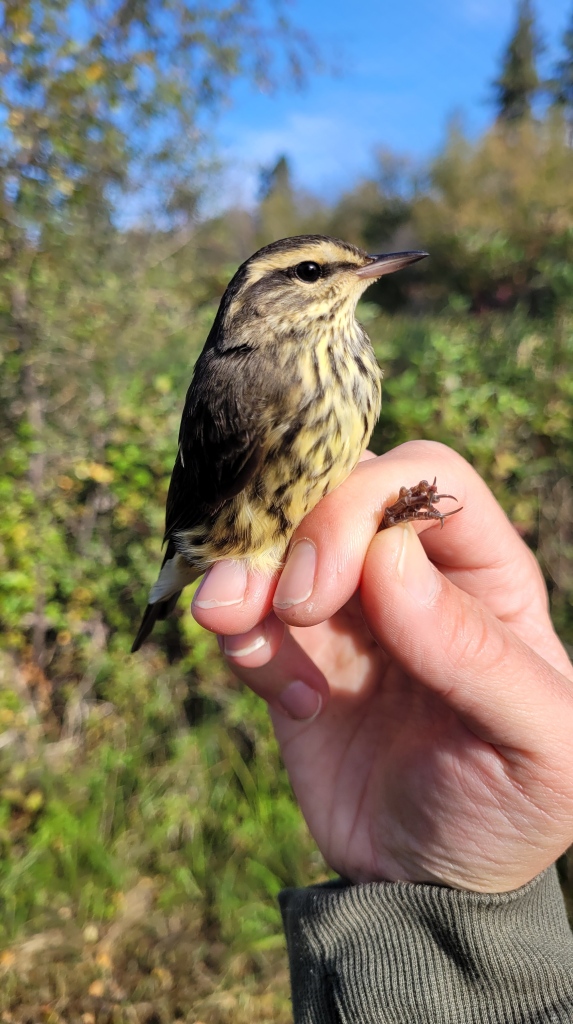

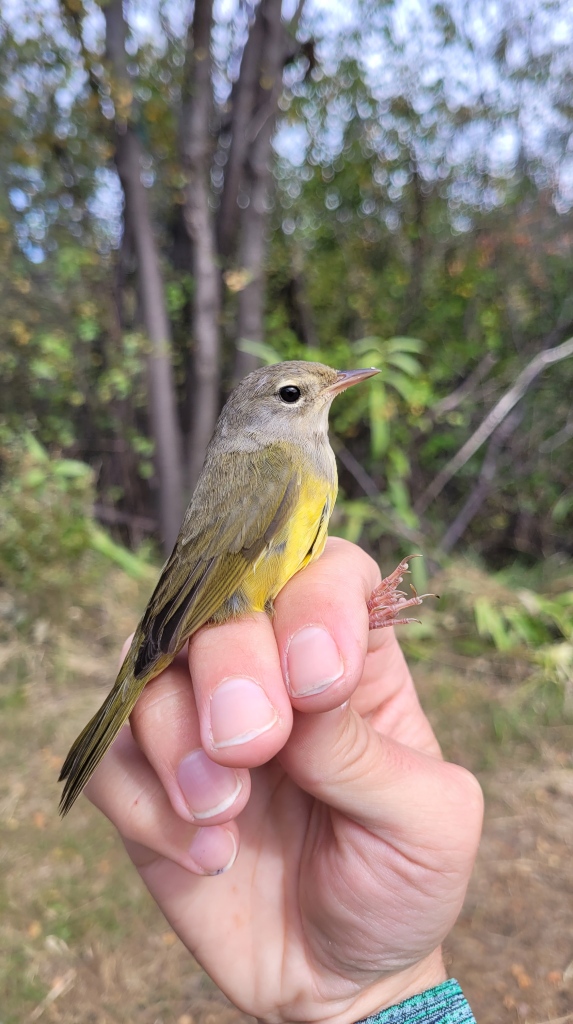
Orange-crowned Warbler were the most frequently banded species this week with 39 banded, which is still a bit below average (54) for week 8. Following closely were ‘Audubon’s’ Yellow-rumped Warbler with 36 banded, then Common Yellowthroat with 22, and Song Sparrow with 17 in fourth place. While yellow-rumped Warblers moved through in good numbers this week, with almost twice the average number banded, many of our other typical migrants were low this week. Lincoln’s Sparrow were surprisingly few in number with only 9 banded (the week 8 mean is 30), as were Ruby-crowned Kinglet with only 2 banded (mean of 12), and Wilson’s Warbler with 1 (mean of 7).
Interacting with visiting elementary school groups from across the South Okanagan kept us busy during times of slow net runs.
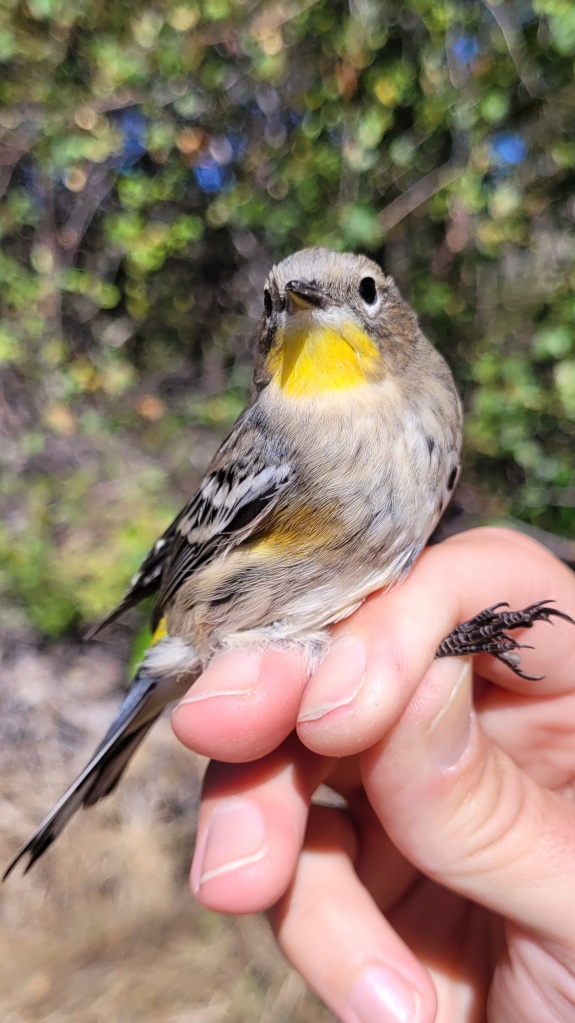
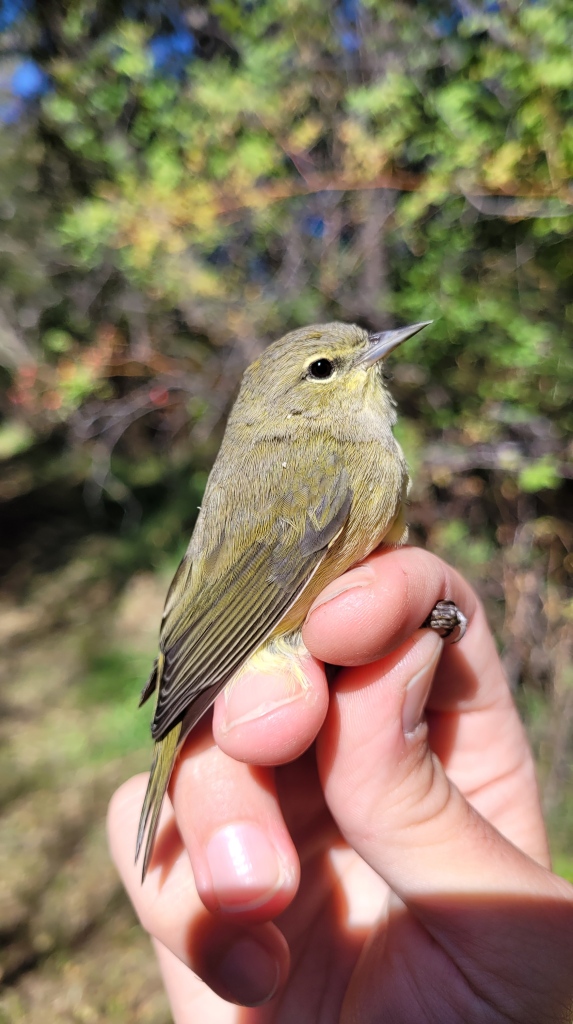
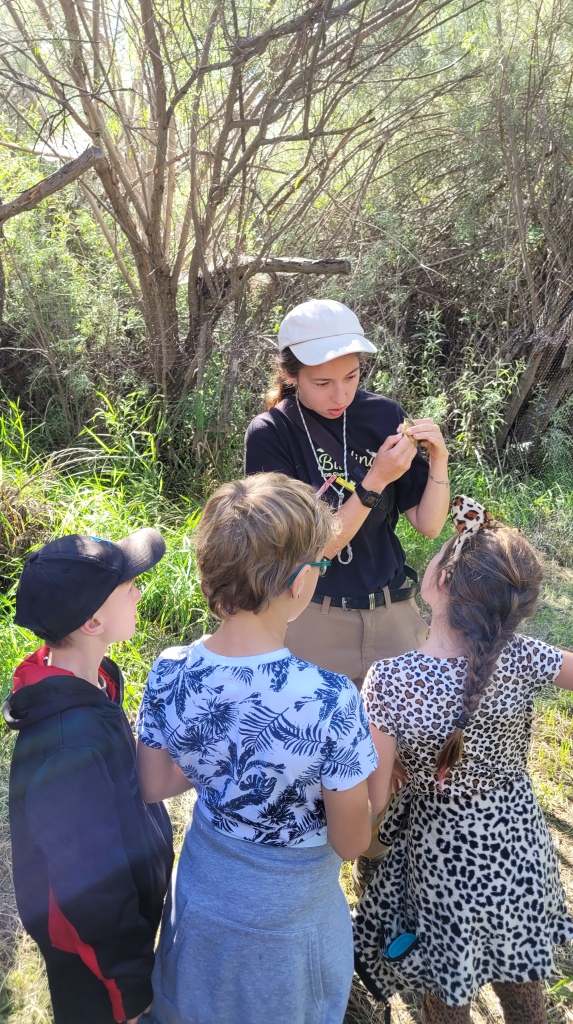
As we near the end of September with little sign of the weather changing, it seems likely too late to see much of an increase in migrant activity from these levels. Only time will tell.
Below are the weekly banding totals:
| Species | Total Banded |
| Orange-crowned Warbler | 39 |
| ‘Audubon’s’ Yellow-rumped Warbler | 36 |
| Common Yellowthroat | 22 |
| Song Sparrow | 17 |
| Lincoln’s Sparrow | 9 |
| ‘Myrtle’ Yellow-rumped Warbler | 6 |
| Marsh Wren | 3 |
| ‘Unidentified’ Yellow-rumped Warbler | 3 |
| White-crowned Sparrow | 2 |
| Ruby-crowned Kinglet | 2 |
| Gray Catbird | 2 |
| Dusky Flycatcher | 2 |
| Clay-colored Sparrow | 2 |
| Spotted Towhee | 1 |
| Wilson’s Warbler | 1 |
| White-throated Sparrow | 1 |
| ‘Red-shafted’ Northern Flicker | 1 |
| Northern Waterthrush | 1 |
| MacGillivray’s Warbler | 1 |
| ‘Oregon’ Dark-eyed Junco | 1 |
| Total | 152 |
2022, Week 7: Sep 12 – 18
During Week 7 (Sep. 12-18) of our fall migration monitoring season we banded 170 birds of 23 species and recaptured 33 birds of 7 species. While this is an improvement from last week’s low total, the numbers are still well below average for Week 7 – the long-term station mean is 220 birds and the mean over the last five years is 282 birds. Interestingly, the species total is actually above the Week 7 average of 21. After a slow start, activity picked up mid-week with 39 new birds on Wednesday, followed by totals in the mid-20s for the remainder of the week. Rainy overnight weather on Monday and Tuesday produced two very wet and foggy mornings, which mixed with smoke from increased fire activity to the south, and is probably what contributed to the light fallout we observed on Wednesday.
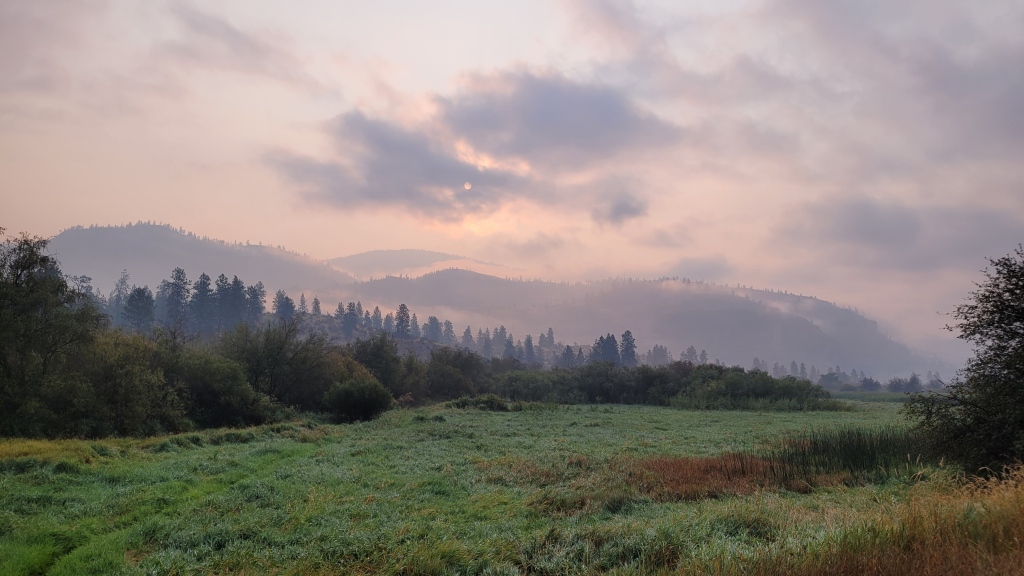
Highlights of the week included four new species for the season: Warbling Vireo, which we caught 5 of in one day, Savannah Sparrow (3), Red-winged Blackbird, and Ruby-crowned Kinglet. Other interesting captures included our second Pacific-slope Flycatcher of the season, third Western Tanager, two more each of Virginia Rail and Sora, as well as our first Sora recapture! We also spotted the black bear that has been frequenting our trails for the first time this week – a yearling swimming across the Okanagan river channel.

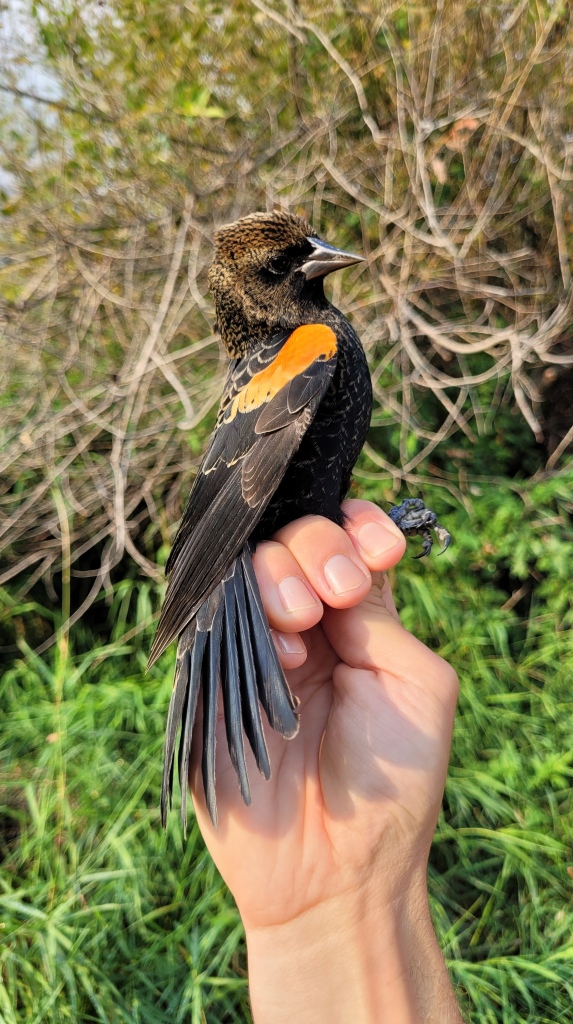
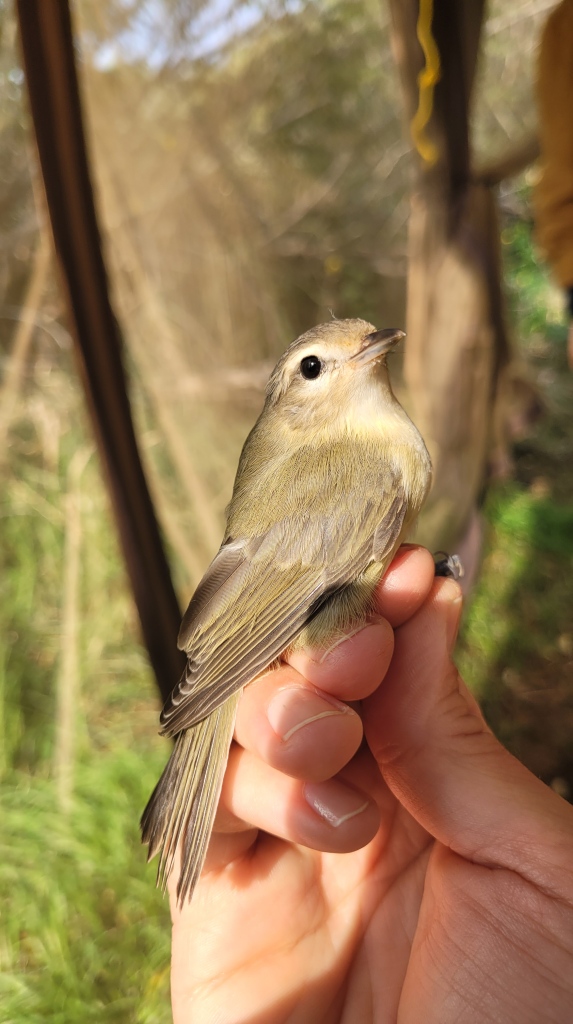
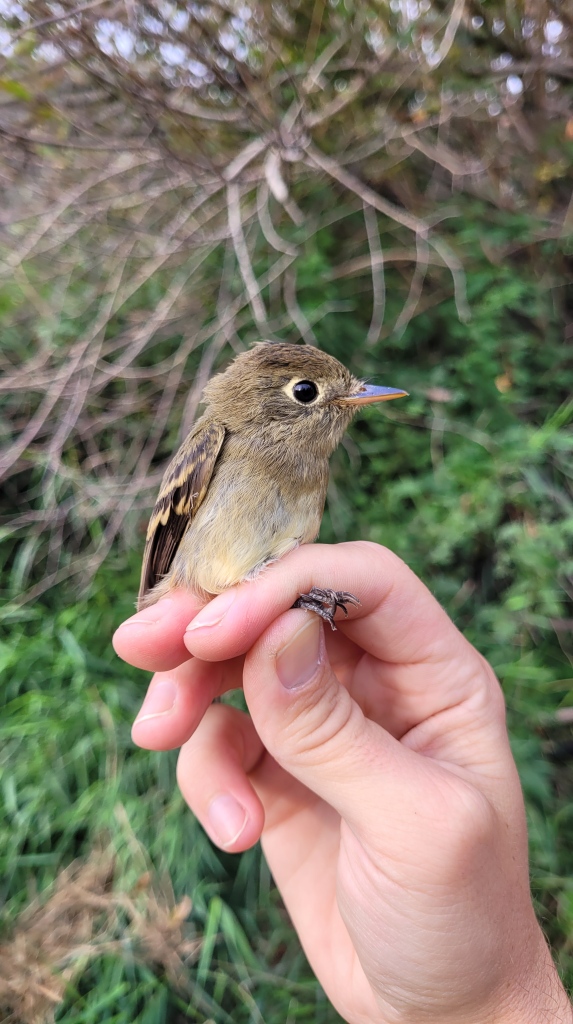
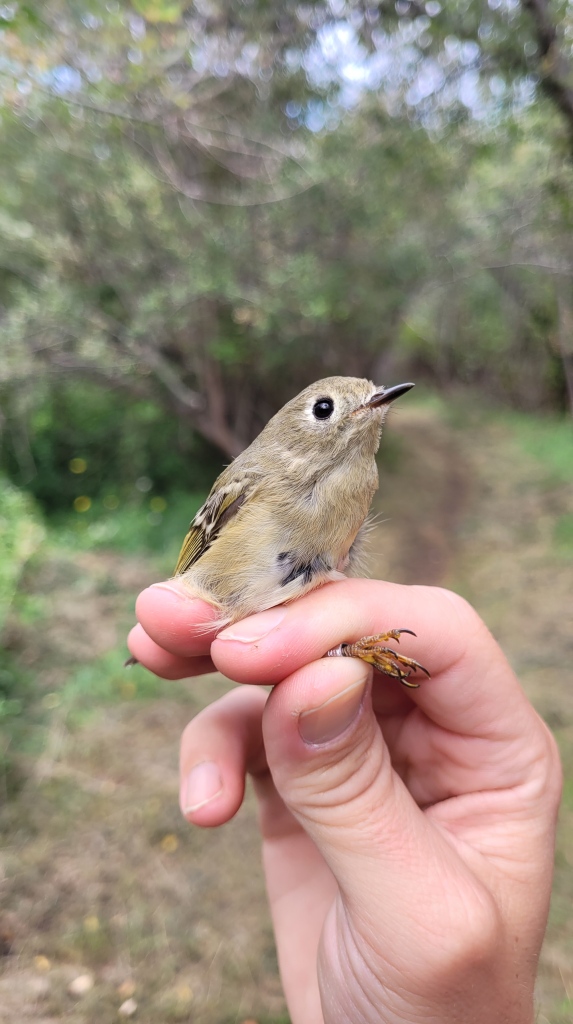
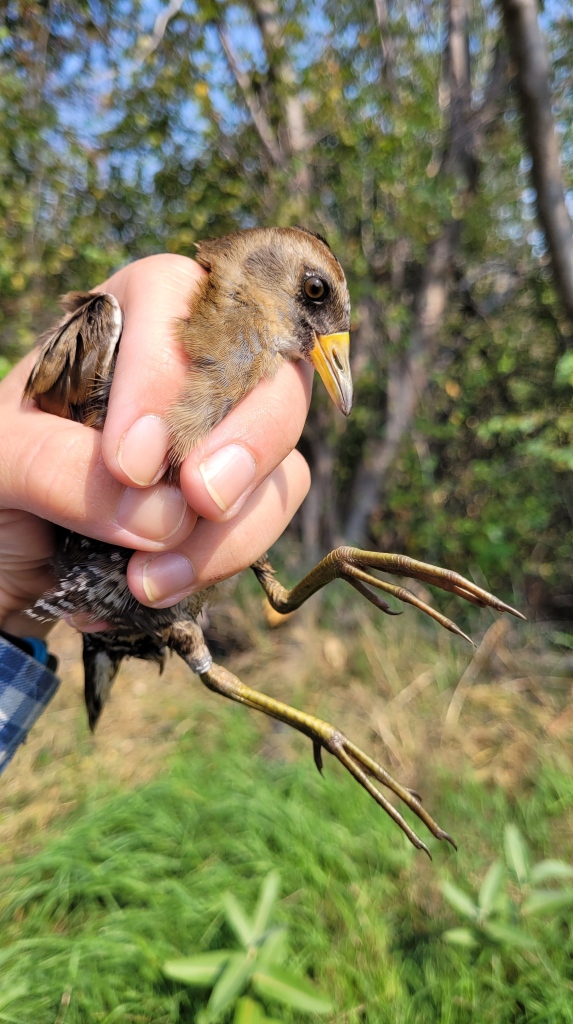
Common Yellowthroat was the most frequently banded species this week with 35, followed closely by Orange-crowned Warbler (32), Lincoln’s Sparrow (27), and then Song Sparrow (22). Of these, Common Yellowthroat and Song Sparrow were slightly above average for week 7 while Lincoln’s Sparrow was slightly below average and Orange-crowned Warbler were only about half the week 7 mean of 60.
Most of our other relatively common migrants were below average this week, including White-crowned Sparrow, Wilson’s Warbler, Audubon’s Warbler, and Ruby-crowned Kinglet. Looking at the season overall, we’ve banded 1122 birds after 7 weeks, which is over 100 birds below the long-term station mean, and over 300 birds less than the mean over the last 10 years (of 1475 birds). Week 8 has been the peak of migration during several of our more recent seasons so we will see if that holds true next week!
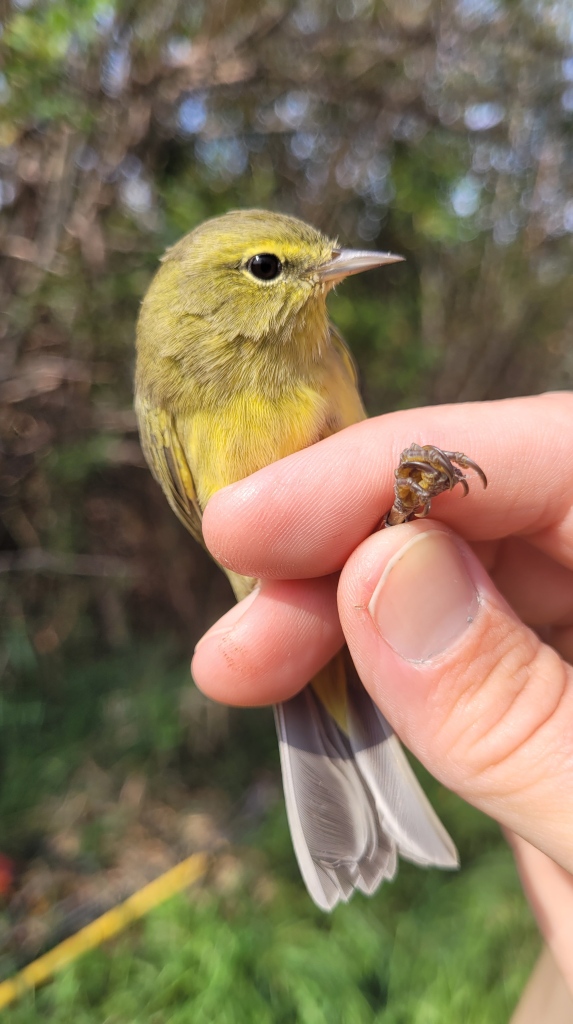
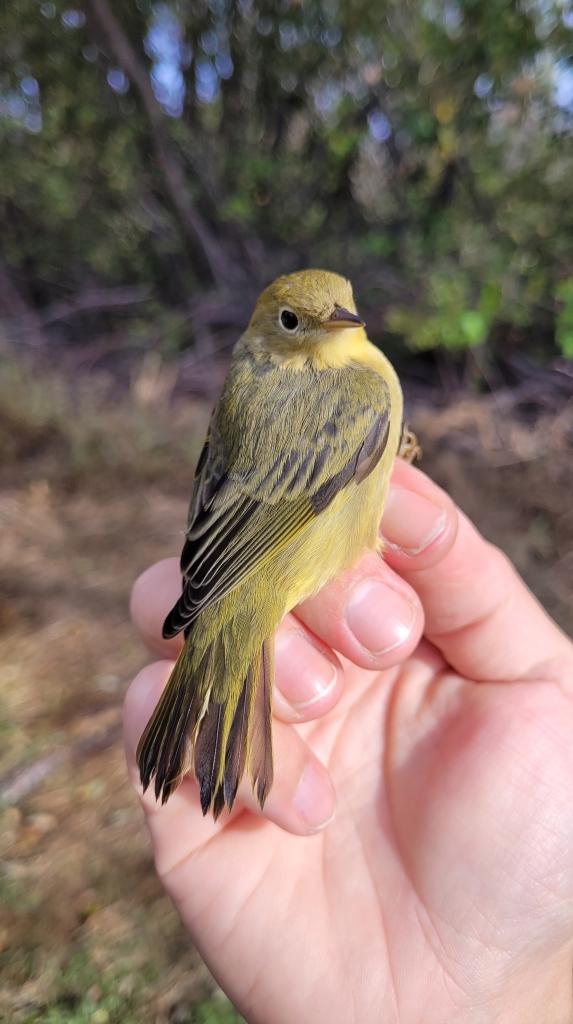
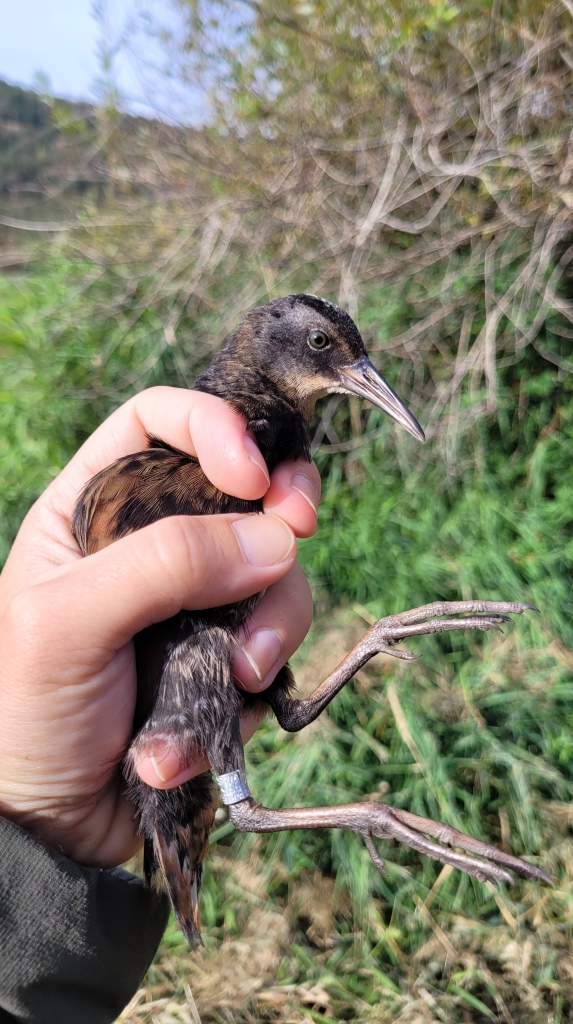
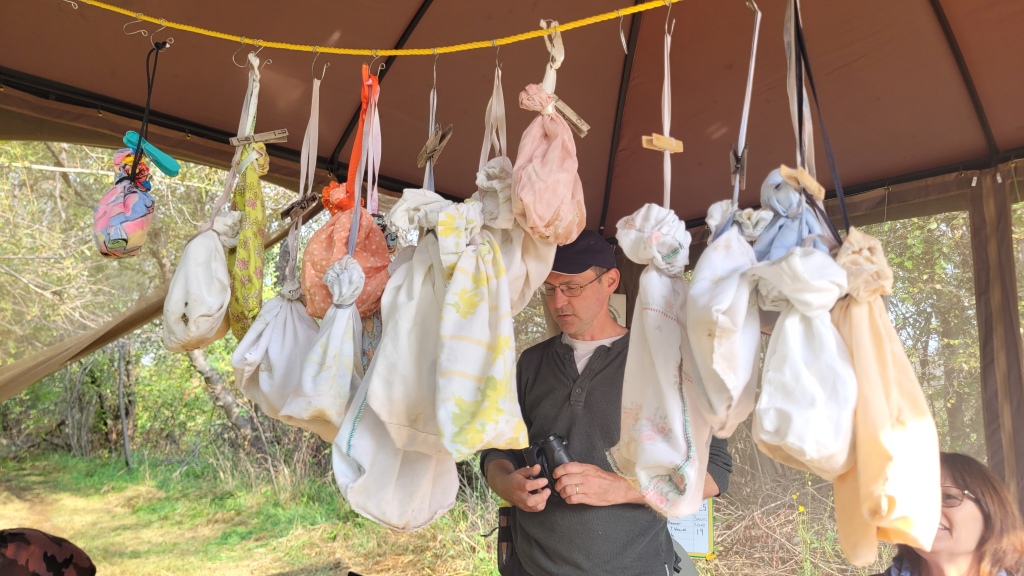
Below are the weekly banding totals:
| Species | Total Banded |
| Common Yellowthroat | 35 |
| Orange-crowned Warbler | 32 |
| Lincoln’s Sparrow | 27 |
| Song Sparrow | 22 |
| ‘Audubon’s’ Yellow-rumped Warbler | 11 |
| Warbling Vireo | 5 |
| White-crowned Sparrow | 5 |
| Gray Catbird | 4 |
| Yellow Warbler | 3 |
| Wilson’s Warbler | 3 |
| Savannah Sparrow | 3 |
| Virginia Rail | 2 |
| Sora | 2 |
| Black-capped Chickadee | 2 |
| Spotted Towhee | 2 |
| Marsh Wren | 2 |
| Unidentified Yellow-rumped Warbler | 2 |
| American Goldfinch | 2 |
| Red-winged Blackbird | 1 |
| Bewick’s Wren | 1 |
| Lazuli Bunting | 1 |
| Ruby-crowned Kinglet | 1 |
| Western Tanager | 1 |
| Pacific-slope Flycatcher | 1 |
| Total | 119 |
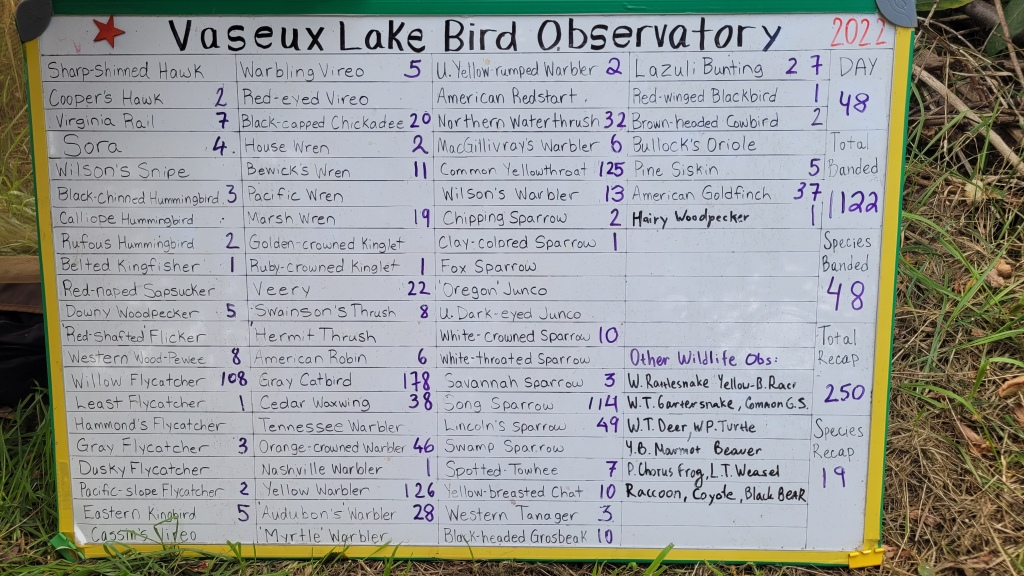
2022, Week 6: Sep 5-11
Week 6 (Sep. 5-11) of our fall migration monitoring season continued at the same slow pace as the previous week, though increased activity near the end of the week gave us some hope that migration will pick up. Overall we banded 119 birds of 21 species and recaptured 30 birds of 9 species, half of which were Song Sparrows. Week 6 is typically when migration activity begins to pick up, after the late August and early September lull. However, that was was not really the case this week with the banding total being well below the long-term mean of 172 for week 6. The busiest day came Friday with 36 birds banded, which was the only above-average day total of the week. We saw the advent of some cool nights, with temperatures dipping down to almost 5°C some mornings, and not exceeding the low to mid 20s by shift end.
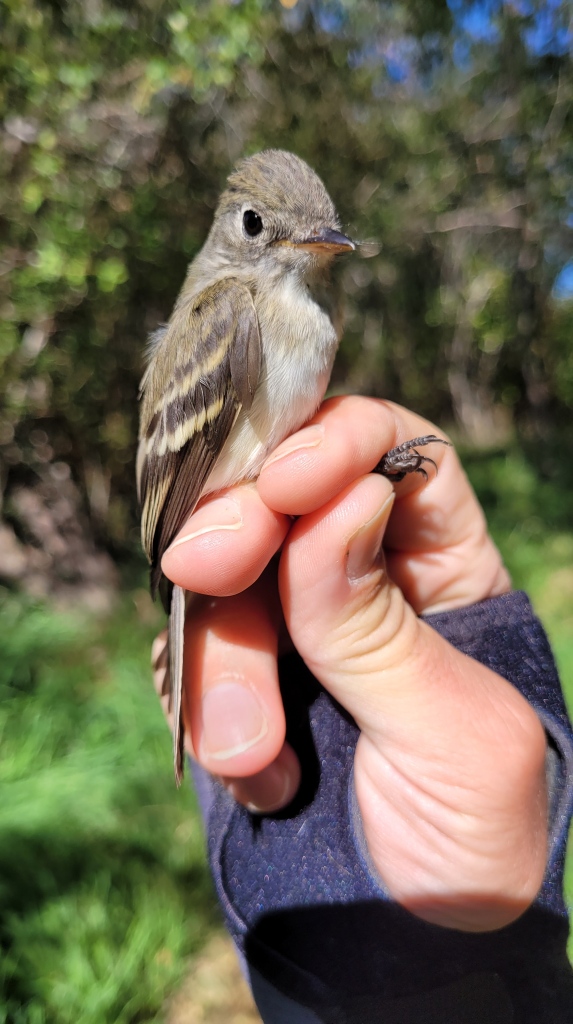
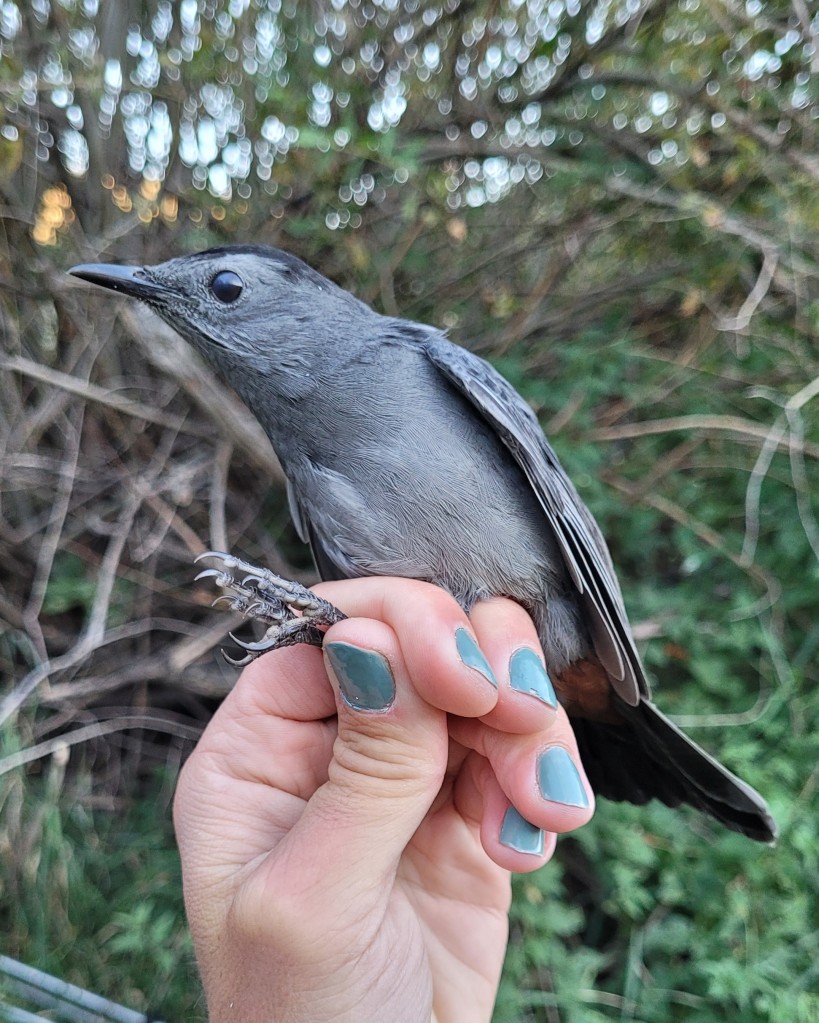
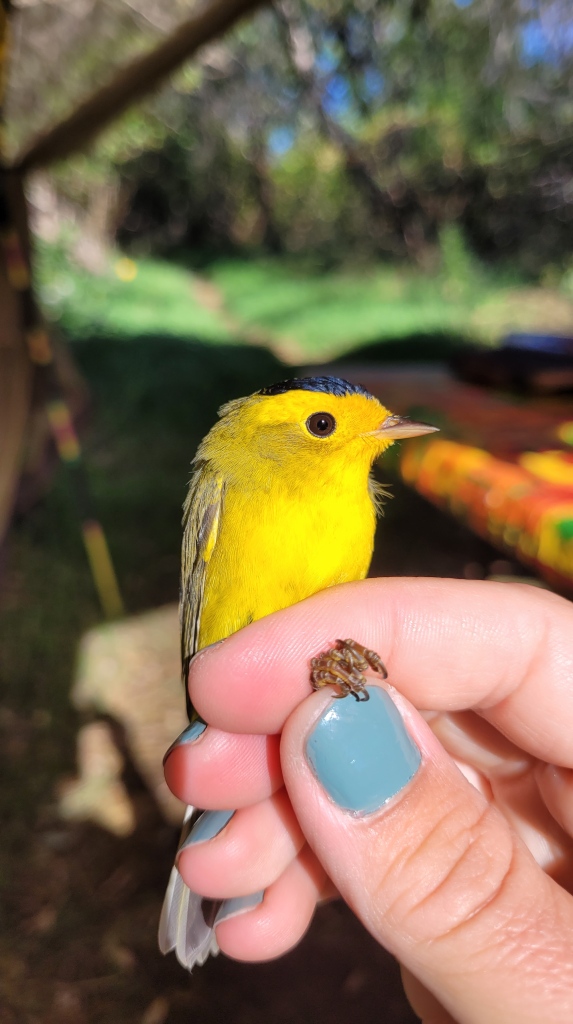
Highlights of the week included three new species: Belted Kingfisher, Least Flycatcher, and finally a Nashville Warbler! Other highlights were 2 more Yellow-breasted Chat and our first MacGillivray’s Warbler for a while.
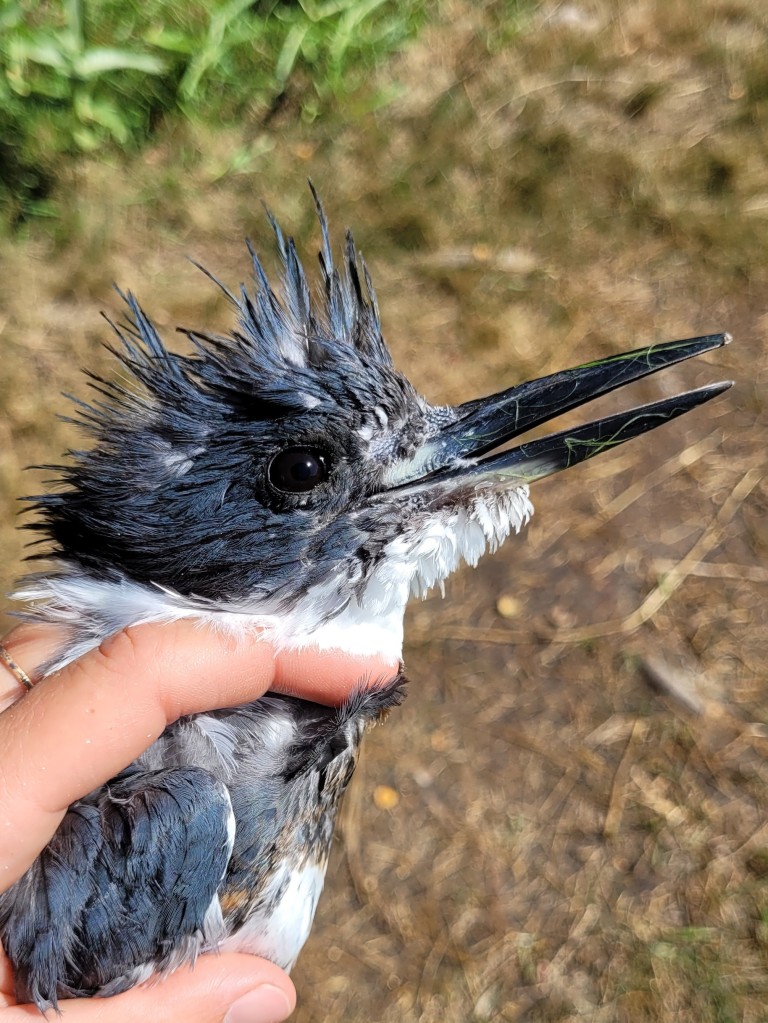
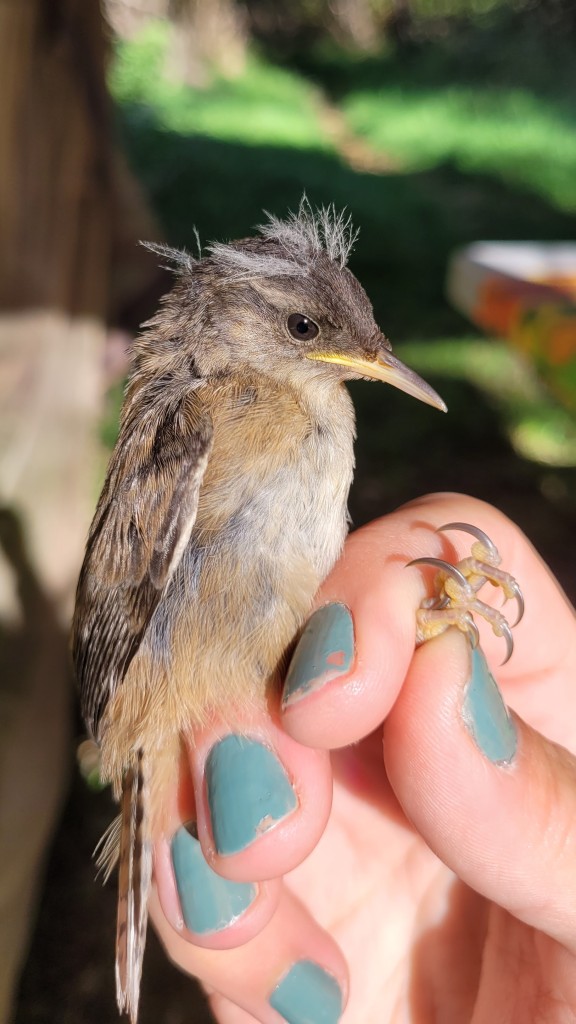
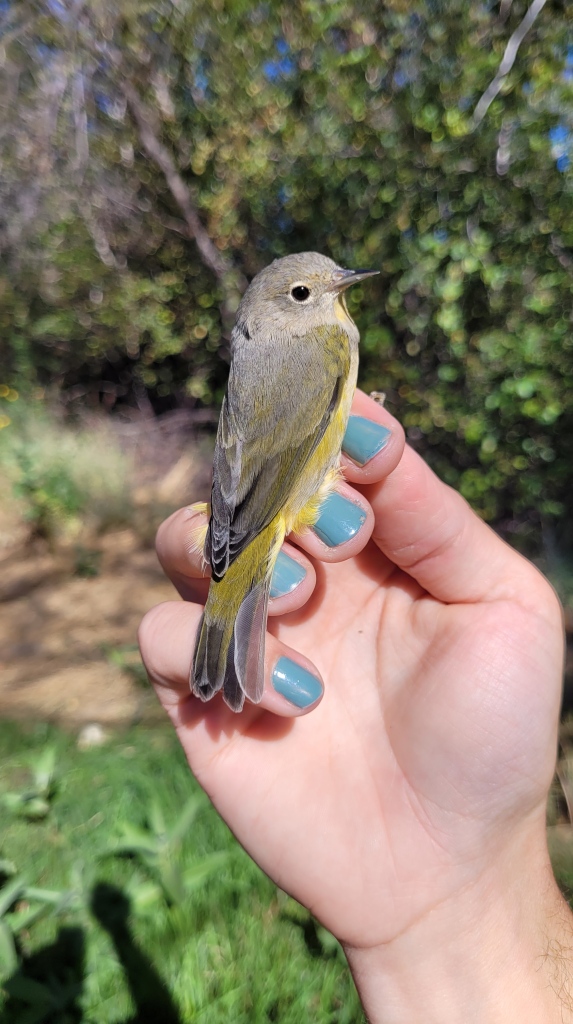
Common Yellowthroat dethroned Gray Catbird at the top spot this week with 22 banded. Song Sparrow and Lincoln’s were tied for second with 15 banded, while Gray Catbird followed in fourth place. Of these, actually only Gray Catbird were above average, while the others were below. Our most abundant migrant, Orange-crowned Warbler, remained well below average with only 8 banded compared to the week 6 mean of 41! However, a few less abundant species fared well this week, including Audubon’s Warbler, Marsh Wren, Lazuli Bunting, American Goldfinch, and even Wilson’s Warbler was slightly above average. We are still missing a few less common migrants entirely so far, namely, Warbling Vireo, Savannah Sparrow and Dusky Flycatcher. While we don’t catch many of these species, at least a handful usually find their way into our nets each season.
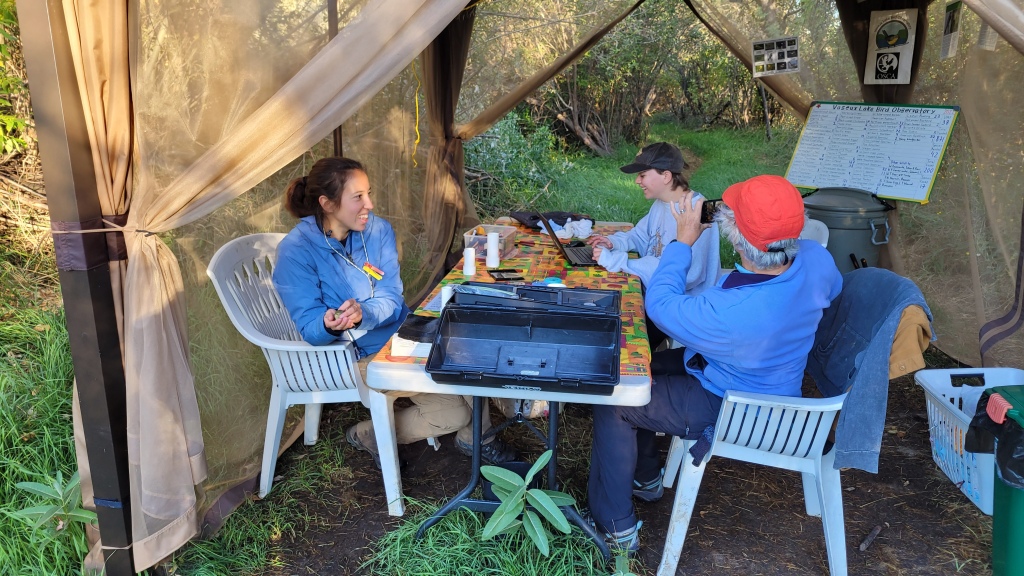
Below are the weekly banding totals:
| Species | Total Banded |
| Common Yellowthroat | 22 |
| Song Sparrow | 15 |
| Lincoln’s Sparrow | 15 |
| Gray Catbird | 13 |
| Audubon’s Warbler | 11 |
| Orange-crowned Warbler | 8 |
| Wilson’s Warbler | 6 |
| Yellow Warbler | 5 |
| American Goldfinch | 4 |
| Marsh Wren | 4 |
| Lazuli Bunting | 3 |
| Yellow-breasted Chat | 2 |
| White-crowned Sparrow | 2 |
| Willow Flycatcher | 2 |
| Veery | 1 |
| Nashville Warbler | 1 |
| Black-capped Chickadee | 1 |
| Cedar Waxwing | 1 |
| Belted Kingfisher | 1 |
| Least Flycatcher | 1 |
| MacGillivray’s Warbler | 1 |
| Total | 119 |
2022, Week 5: Aug 29 – Sep 4
The fifth week (Aug. 29-Sep. 4) of our fall migration monitoring season was a quiet one with only 99 birds banded of 18 species, and 41 birds recaptured of 12 species. Late August and early September is expectedly slow for bird activity, but with a long-term mean of 131 birds banded and a 10-year mean of 149, this is one of the slowest fifth weeks in recent history, since 2013. Only on Tuesday did we exceed 20 birds banded, which was followed by the slowest day of the season with only 7 birds.
August concluded with 775 birds banded, just slightly below the long-term mean of 781, but considerably lower than the 10-year mean of 940. However, August of 2021 was slower still and then September ended up being very busy. Forty-one species were banded during the month, below the long-term mean of 44.
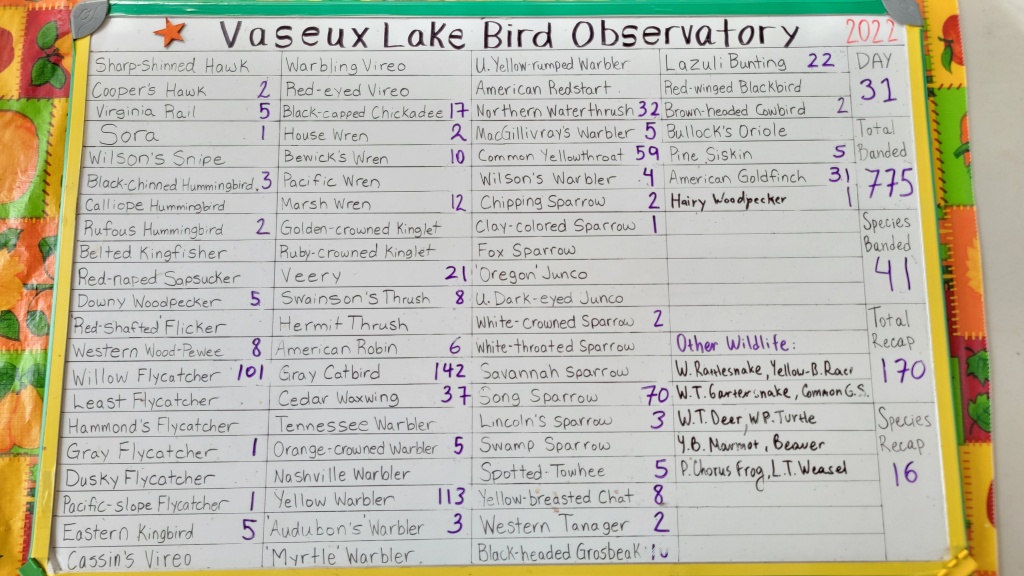
The highlights of the week were certainly two Soras which we had anxiously been awaiting, caught on separate occasions. We don’t catch as many of the smaller rail species, and it was a delight to get two in one week! Also exciting were two additional Gray Flycatchers, which gives us a new season record of 3 for this rare species!
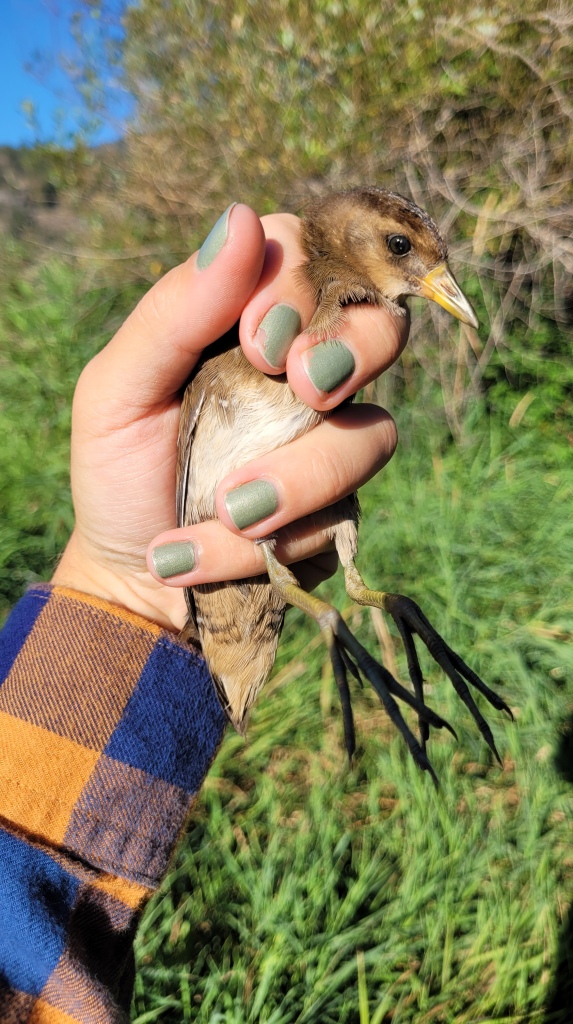
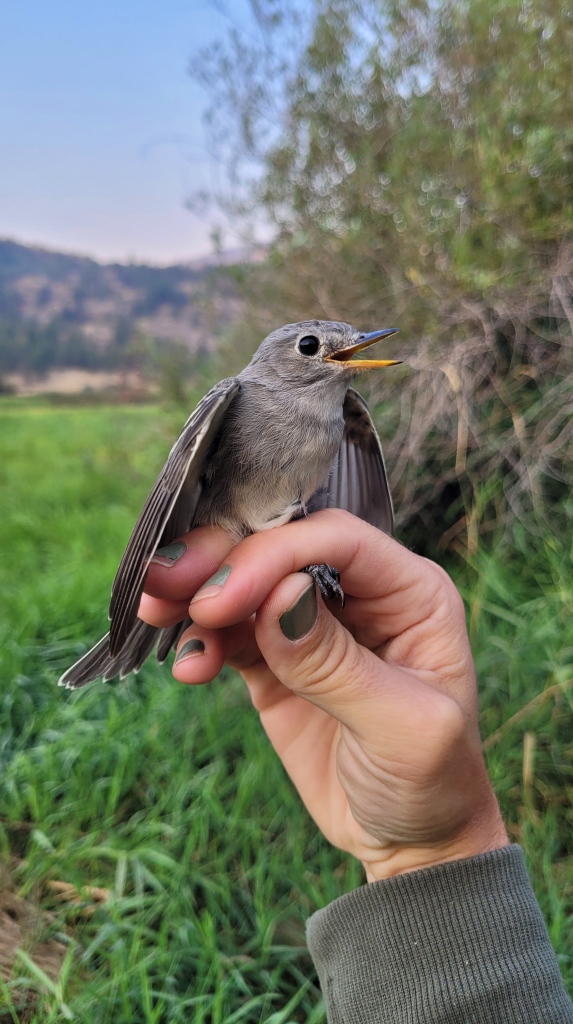

Once again, Gray Catbird was the top species banded this week with 26, while Common Yellowthroat moved into the second spot with 16, followed by Song Sparrow in third with 15, and Willow Flycatcher with 10. Yellow Warbler dropped all the way down to fifth place this week with only 6 banded. Most of our overall top 5 were all relatively on par this week with the exception of Willow Flycatcher which were well above average still, likely a result of some late broods at the station this season.
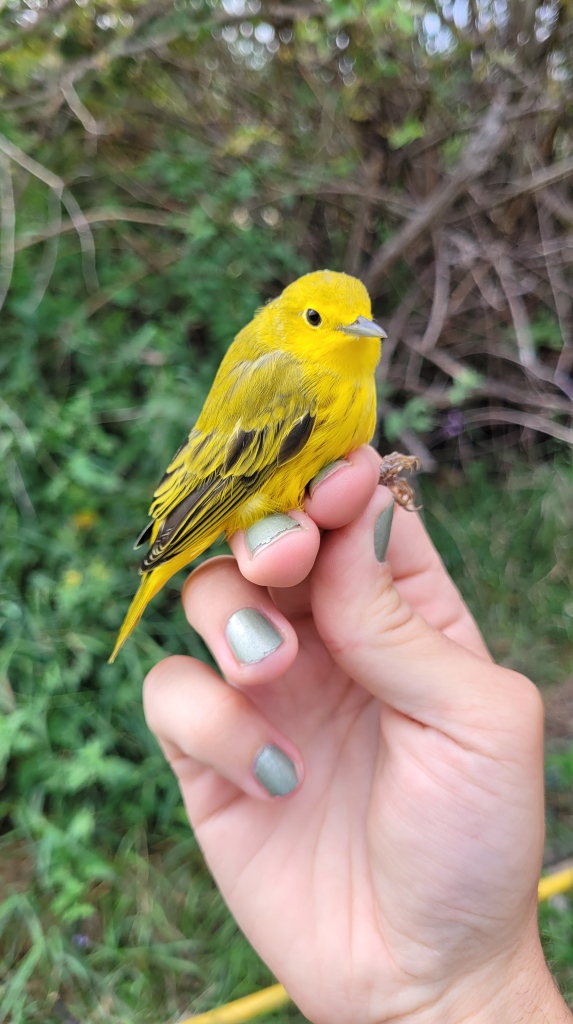
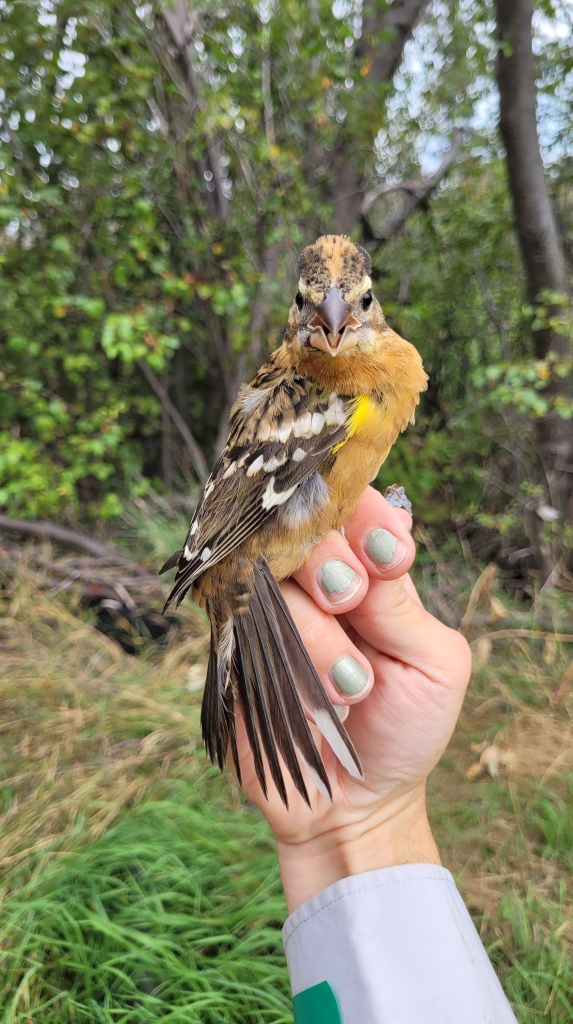
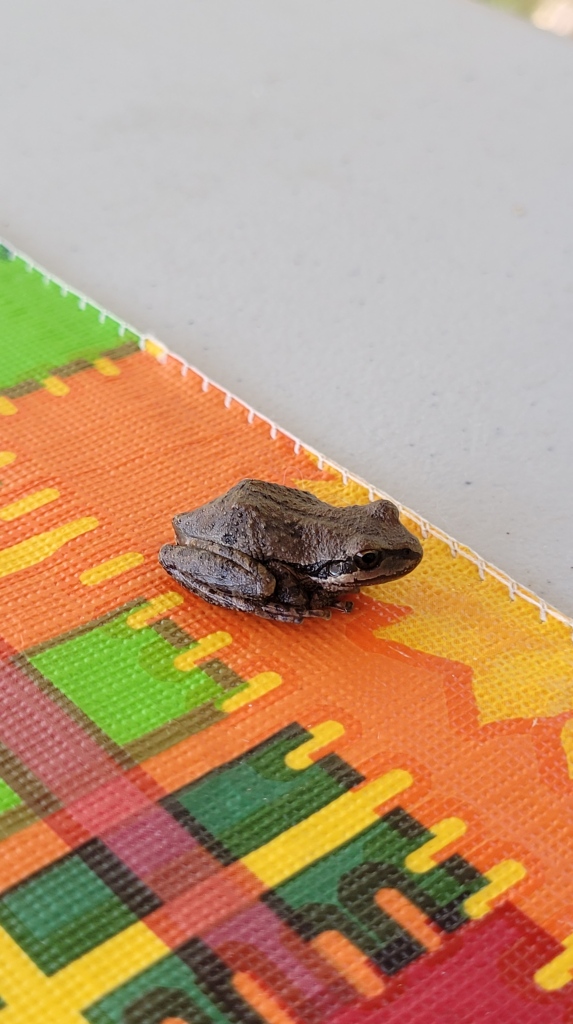
The story of absent migrants continues as our common fall migrants are once again not showing up in the numbers we are accustomed to. Orange-crowned Warbler were far below average; we only banded 2 compared to the week 5 mean of 18.5, while we missed Wilson’s Warbler entirely (the mean is 4). Lincoln’s Sparrow should also be much more common at this point (with a week 5 mean of 16.5) but we only banded 5. Another group that has been absent so far are vireos, which we don’t catch many of but by this point we usually see a steady trickle of Warbling. The absence of migrants explain our low overall numbers; hopefully they are just late which means activity should really pick up over the next couple of weeks!
Below are the weekly banding totals:
| Species | Total Banded |
| Gray Catbird | 26 |
| Common Yellowthroat | 16 |
| Song Sparrow | 15 |
| Willow Flycatcher | 10 |
| Yellow Warbler | 6 |
| Lincoln’s Sparrow | 5 |
| Lazuli Bunting | 4 |
| ‘Audubon’s’ Warbler | 3 |
| Gray Flycatcher | 2 |
| Sora | 2 |
| Orange-crowned Warbler | 2 |
| White-crowned Sparrow | 2 |
| Veery | 1 |
| Pine Siskin | 1 |
| Marsh Wren | 1 |
| Spotted Towhee | 1 |
| Swainson’s Thrush | 1 |
| Northern Waterthrush | 1 |
| Total | 99 |

2022: Week 4, Aug. 22-28
The fourth week (Aug. 22-28) of our fall banding program was an interesting one with 175 birds banded of 30 species and an additional 37 birds of 9 species recaptured. The banding total and number of species is actually above average for the first time this year as week 4 is typically one of the slowest of our fall season, with a long-term mean of 132 birds of 24 species banded. The week ended busier than it began with 34 birds banded on both Friday and Sunday which are in fact record high totals for those respective days. A few cooler days interrupted the recent consistent heat we’ve been getting, including an overcast day with intermittent drizzle on Saturday following by a surprisingly cold overnight low (6.9°C) after net opening the next morning.
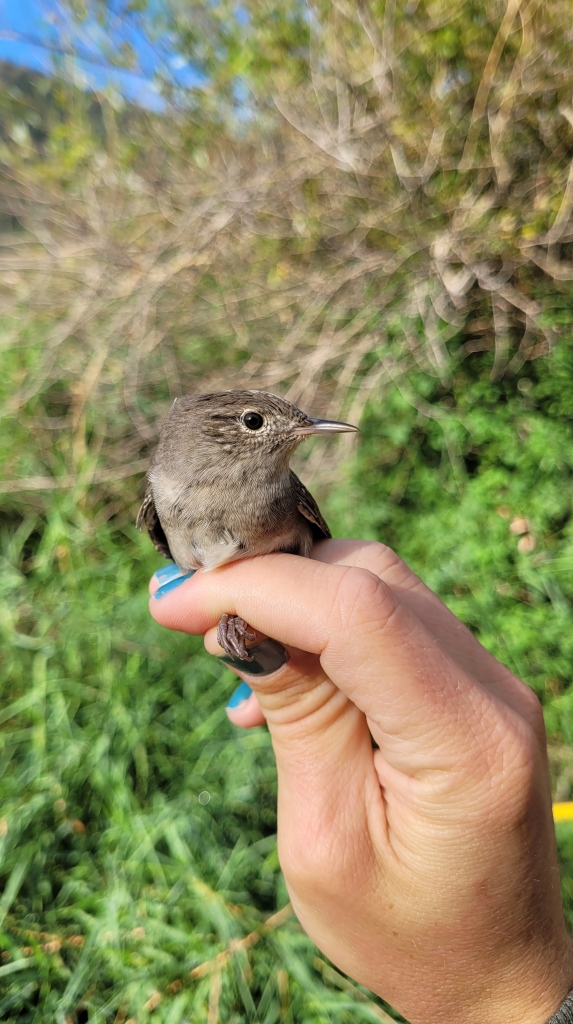
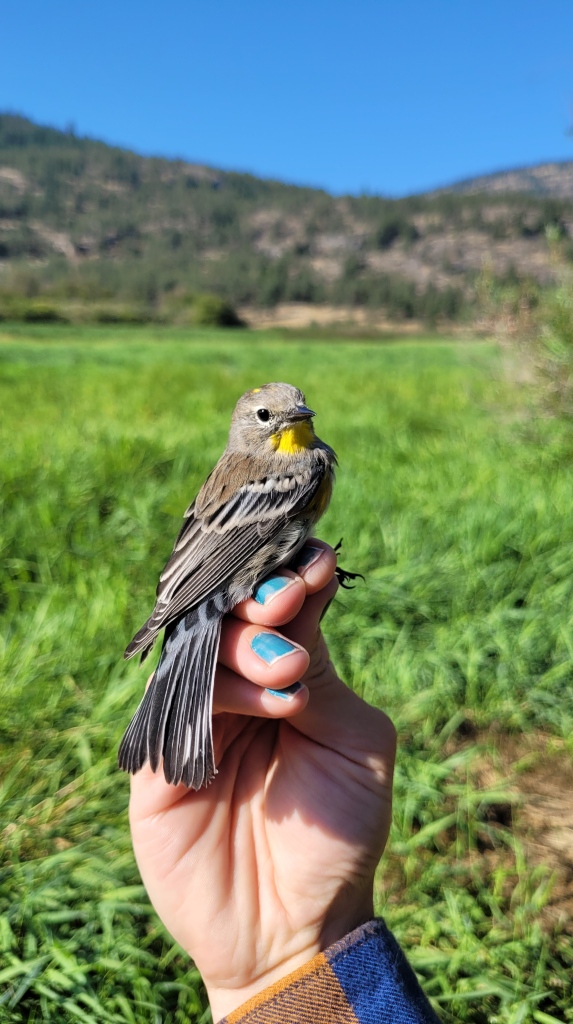

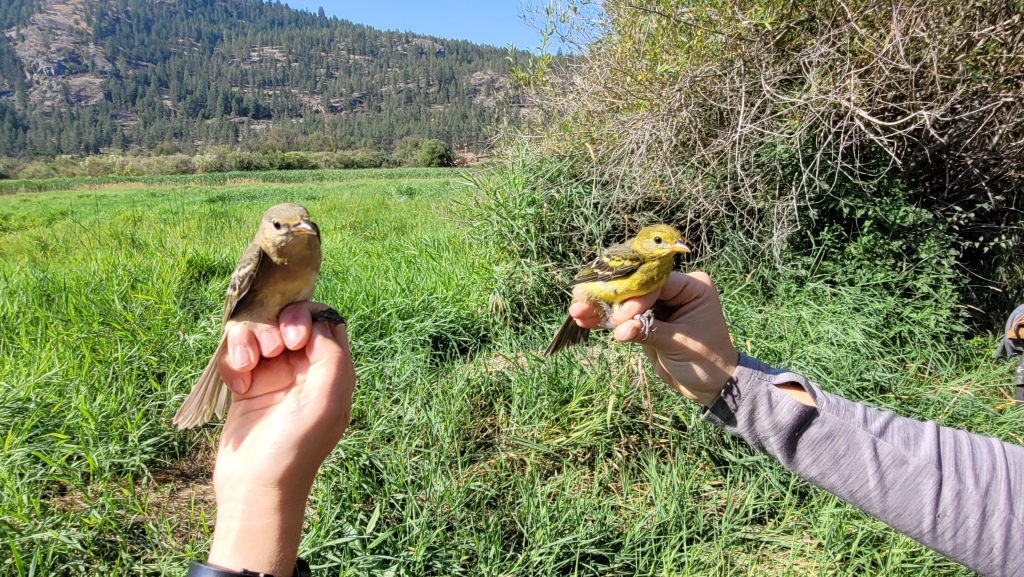
We netted many interesting birds this week; as the relatively high species total indicates, several species were banded with only one individual each. Highlights included five new species for the season: Clay-colored Sparrow, White-crowned Sparrow, Audubon’s Warbler, House Wren (2), and Western Tanager (2). Other highlights were our 2nd Cooper’s Hawk, 2nd Chipping Sparrow, and two more Virginia Rails!
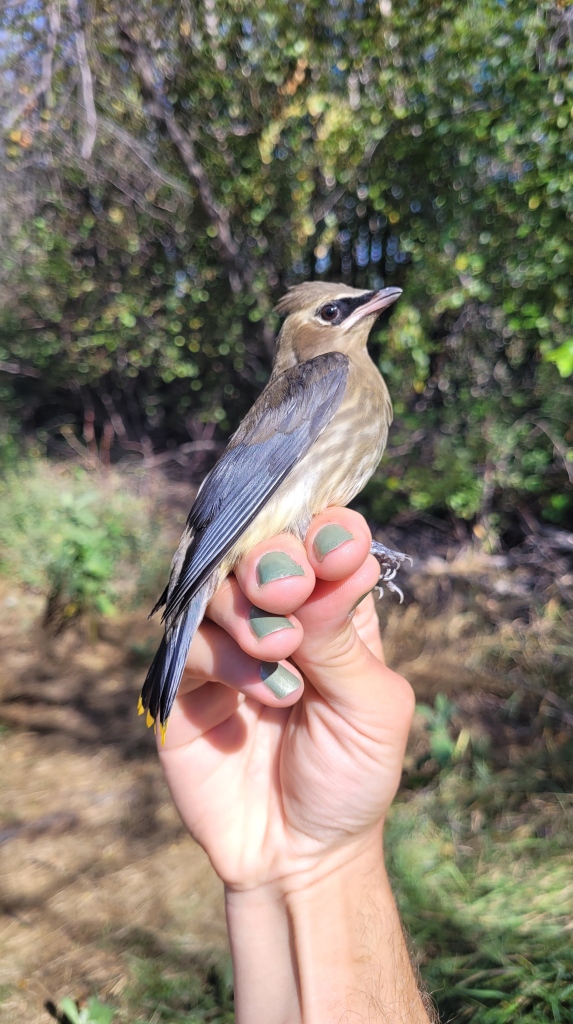
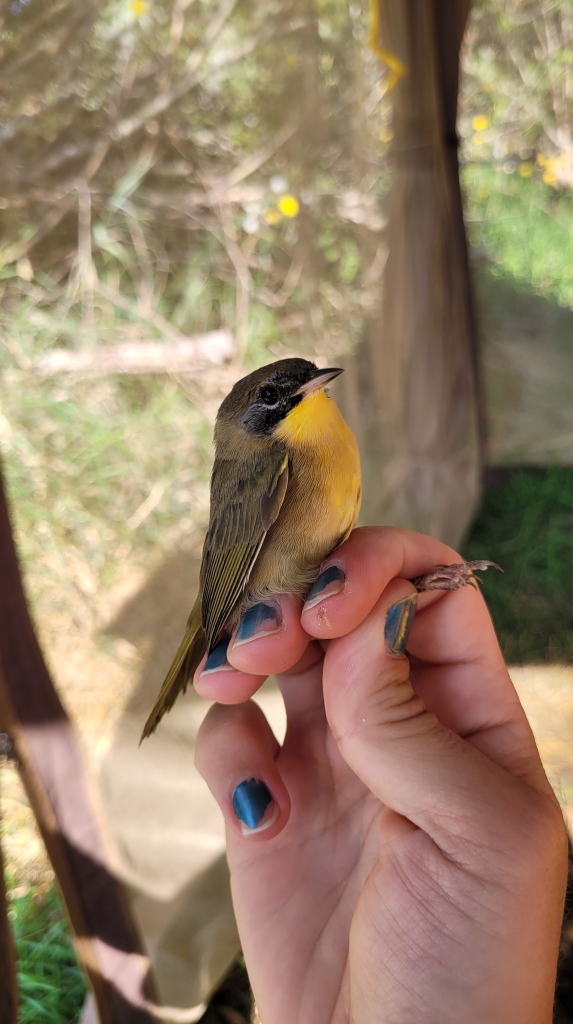
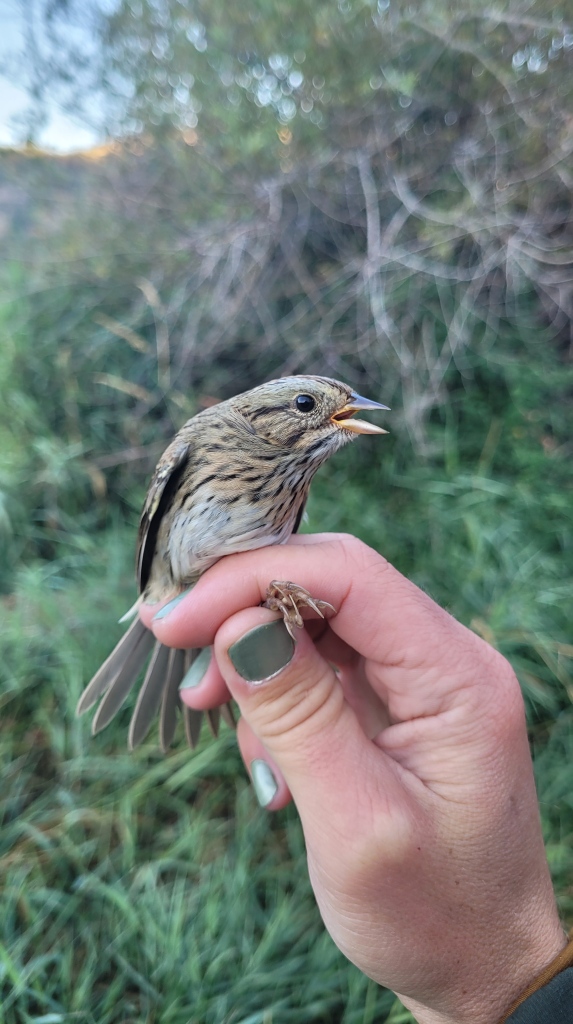
Gray Catbird continued their dominance of the leaderboard with 36 banded, followed by Yellow Warbler with 27, Willow Flycatcher with 23 and Common Yellowthroat with 15. Lazuli Bunting was a bit mover this week with 11 banded, while Northern Waterthrush had another strong week with 10; both several orders of magnitude above the respective means for week 4 – 0.9 and 3.5. The rest of the aforementioned species are also well above average this week, with the exception of Common Yellowthroat, which were close to average, as were Song Sparrow. Once again, our common migrants, Lincoln’s Sparrow, Orange-crowned Warbler, and Wilson’s Warblers were well below average, which continues the trend of late migration. Other less commonly banded fall warblers such as Nashville and MacGillivray’s were completely absent this week.

Below are the weekly banding totals:
| Species | Total Banded |
| Gray Catbird | 36 |
| Yellow Warbler | 27 |
| Willow Flycatcher | 23 |
| Common Yellowthroat | 15 |
| Lazuli Bunting | 11 |
| Song Sparrow | 10 |
| Northern Waterthrush | 10 |
| Cedar Waxwing | 4 |
| Black-capped Chickadee | 4 |
| Spotted Towhee | 3 |
| ‘Audubon’s’ Warbler | 3 |
| American Goldfinch | 3 |
| Orange-crowned Warbler | 3 |
| House Wren | 2 |
| Veery | 2 |
| Swainson’s Thrush | 2 |
| Virginia Rail | 2 |
| Bewick’s Wren | 2 |
| Western Tanager | 2 |
| Clay-colored Sparrow | 1 |
| Lincoln’s Sparrow | 1 |
| Downy Woodpecker | 1 |
| Yellow-breasted Chat | 1 |
| MacGillivray’s Warbler | 1 |
| Chipping Sparrow | 1 |
| Wilson’s Warbler | 1 |
| Pine Siskin | 1 |
| Black-headed Grosbeak | 1 |
| Cooper’s Hawk | 1 |
| White-crowned Sparrow | 1 |
| Grand Total | 175 |
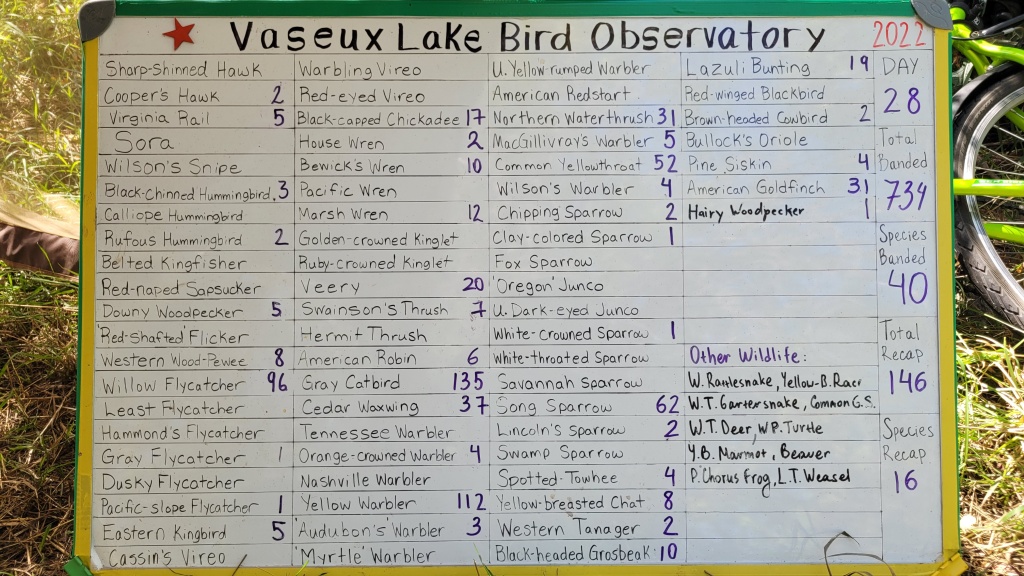

2022: Week 3, Aug 15-21
Week 3 (Aug 15-21) of our fall migration monitoring program was quite slow, even when considering that this is historically a quiet time of the season. We banded 149 birds of 22 species compared to the long-term average of 170 birds banded of 26 species for Week 3. We also recaptured 39 birds of 13 species, of which Song Sparrow and Common Yellowthroat were the most frequent. The slowest day of the week was Thursday with only 11 birds banded, while Sunday produced a bit more activity with 30 banded. Conditions were similarly hot, clear and calm throughout most of the week.

The most interesting captures of the week included our third Virginia Rail, 2 Black-chinned Hummingbirds and a Chipping Sparrow – a locally common species that rarely strays into the wetland habitat around the station. Another highlight came when an American Redstart made a brief appearance in the large willow shrub right behind the banding tent, but unfortunately it did not find its way into any of our nets! Also exciting was the third sighting of a Western Rattlesnake which has been hanging out on the dike along the census route!
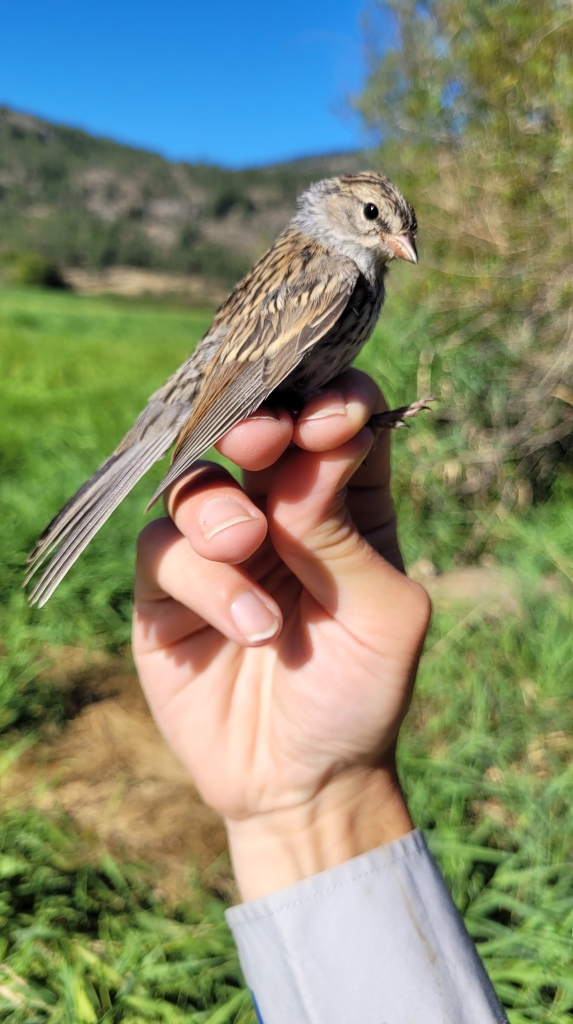
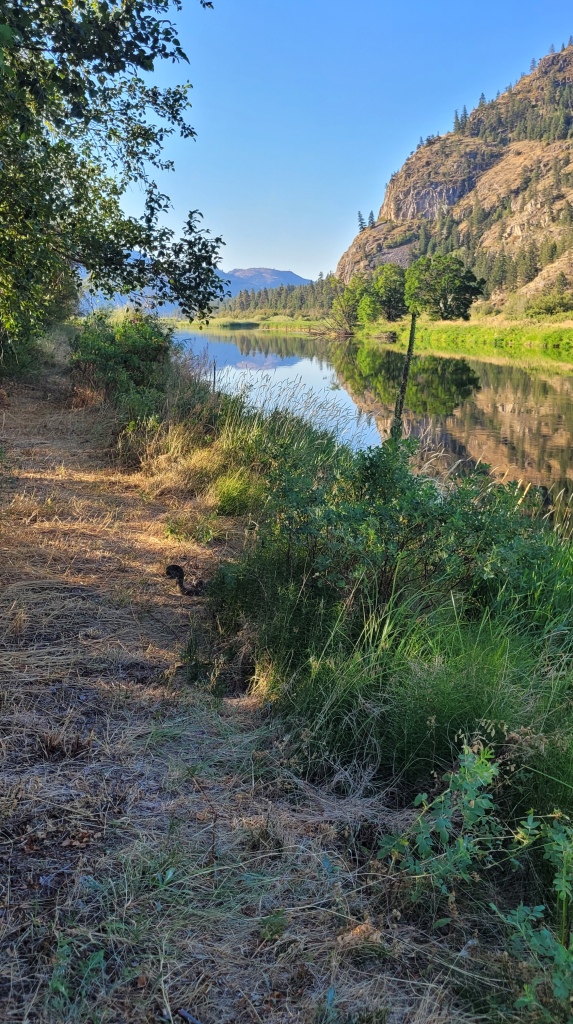

Gray Catbird regained the top spot of most banded birds this week with 39 birds banded which is just above average. Willow Flycatcher followed with 29 which is above average, then Yellow Warbler with a close to average 21, and finally Northern Waterthrush, a new entry to the top four with 11 banded, which is twice the average for week 3.
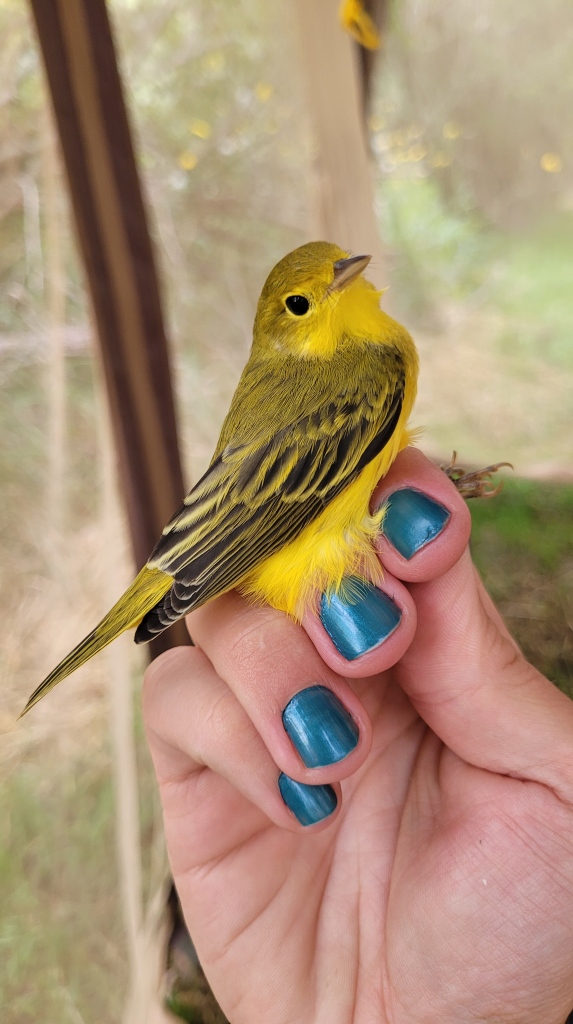

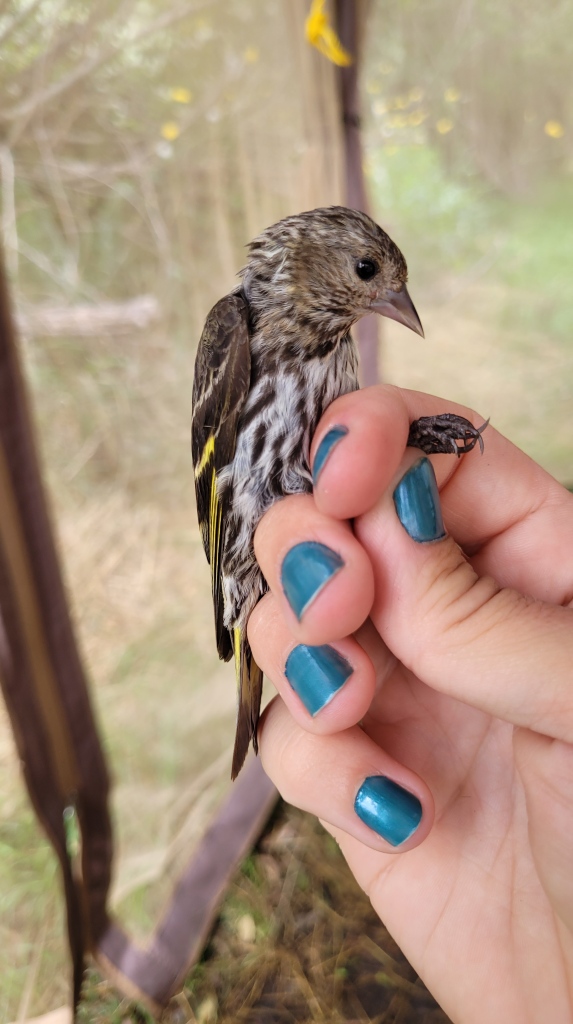
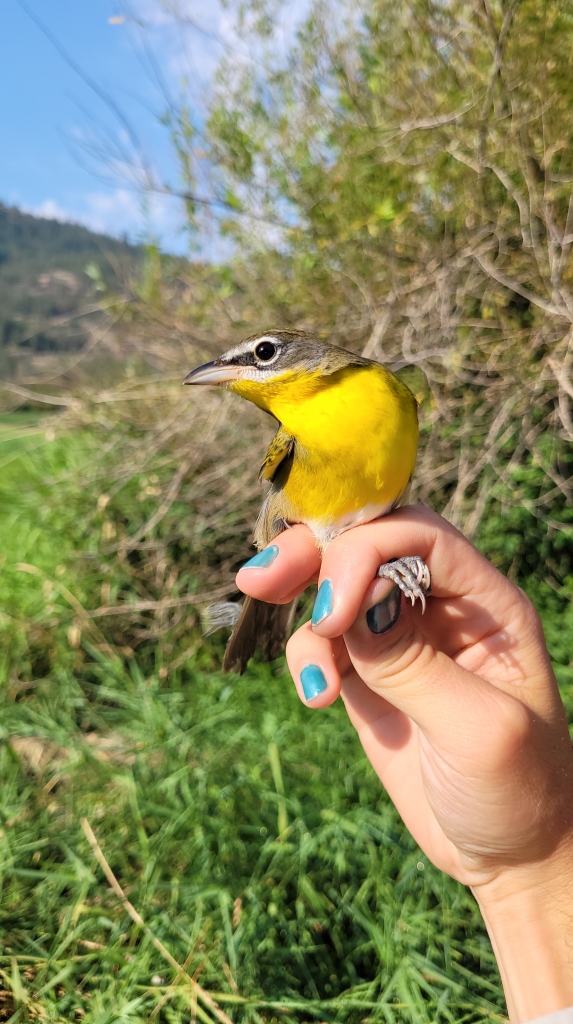
Lazuli Bunting continued their good season with 4 banded this week, and while most other common species were below average including American Goldfinch, Cedar Waxwing, and Common Yellowthroat, while Song Sparrow were right about average. Interestingly, we banded no Orange-crowned Warblers or Wilson’s Warblers this week, two of our more common fall migrants which usually begin to trickle in by now.
Below are the weekly banding totals:
| Species | Total Banded |
| Gray Catbird | 39 |
| Willow Flycatcher | 29 |
| Yellow Warbler | 21 |
| Northern Waterthrush | 11 |
| Song Sparrow | 10 |
| Common Yellowthroat | 7 |
| Veery | 4 |
| Lazuli Bunting | 4 |
| Cedar Waxwing | 3 |
| American Robin | 3 |
| American Goldfinch | 2 |
| Western Wood-Pewee | 2 |
| Yellow-breasted Chat | 2 |
| Downy Woodpecker | 2 |
| Black-chinned Hummingbird | 2 |
| Marsh Wren | 2 |
| Pine Siskin | 1 |
| Swainson’s Thrush | 1 |
| Black-capped Chickadee | 1 |
| Virginia Rail | 1 |
| MacGillivray’s Warbler | 1 |
| Chipping Sparrow | 1 |
| Grand Total | 149 |
